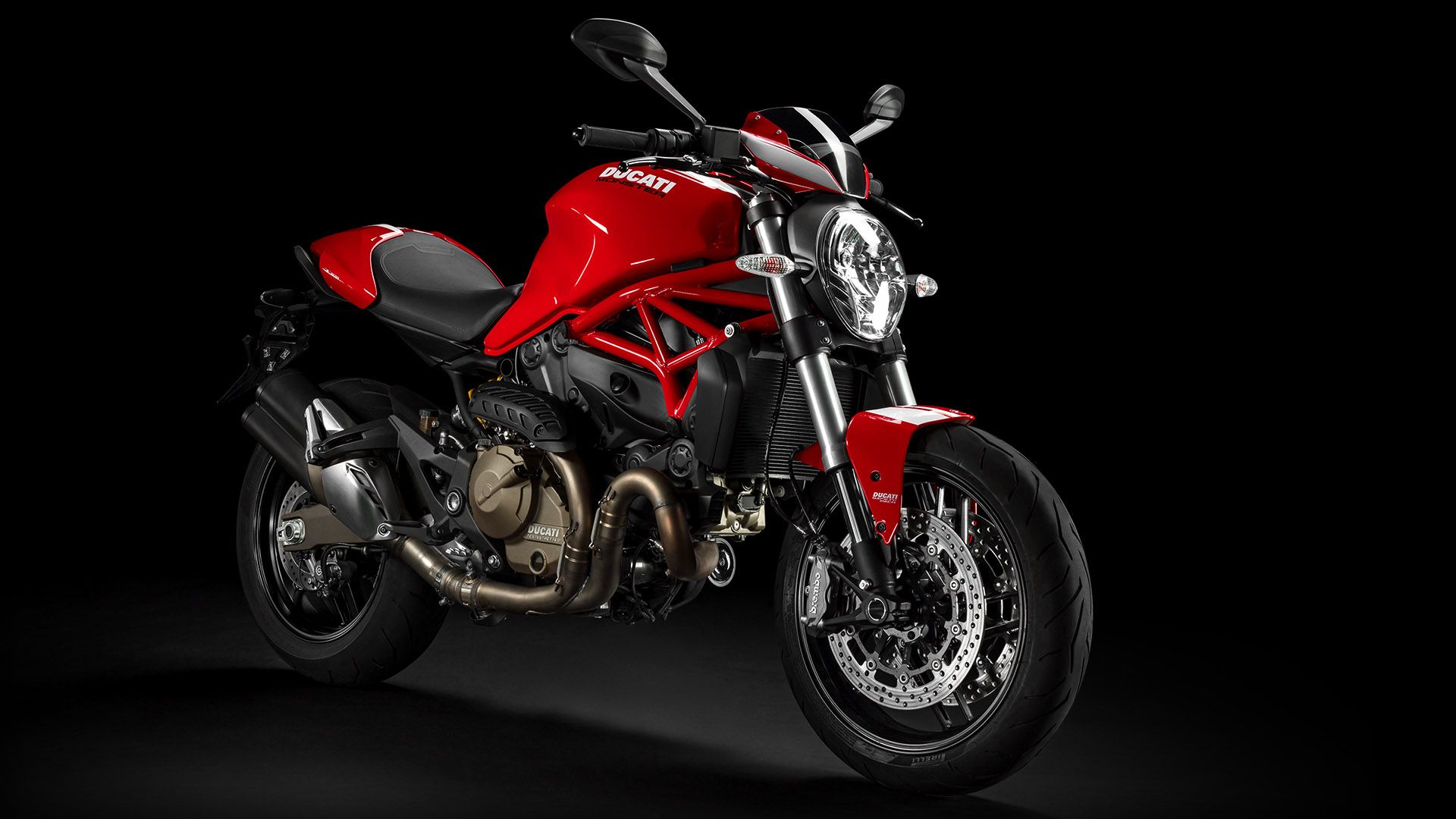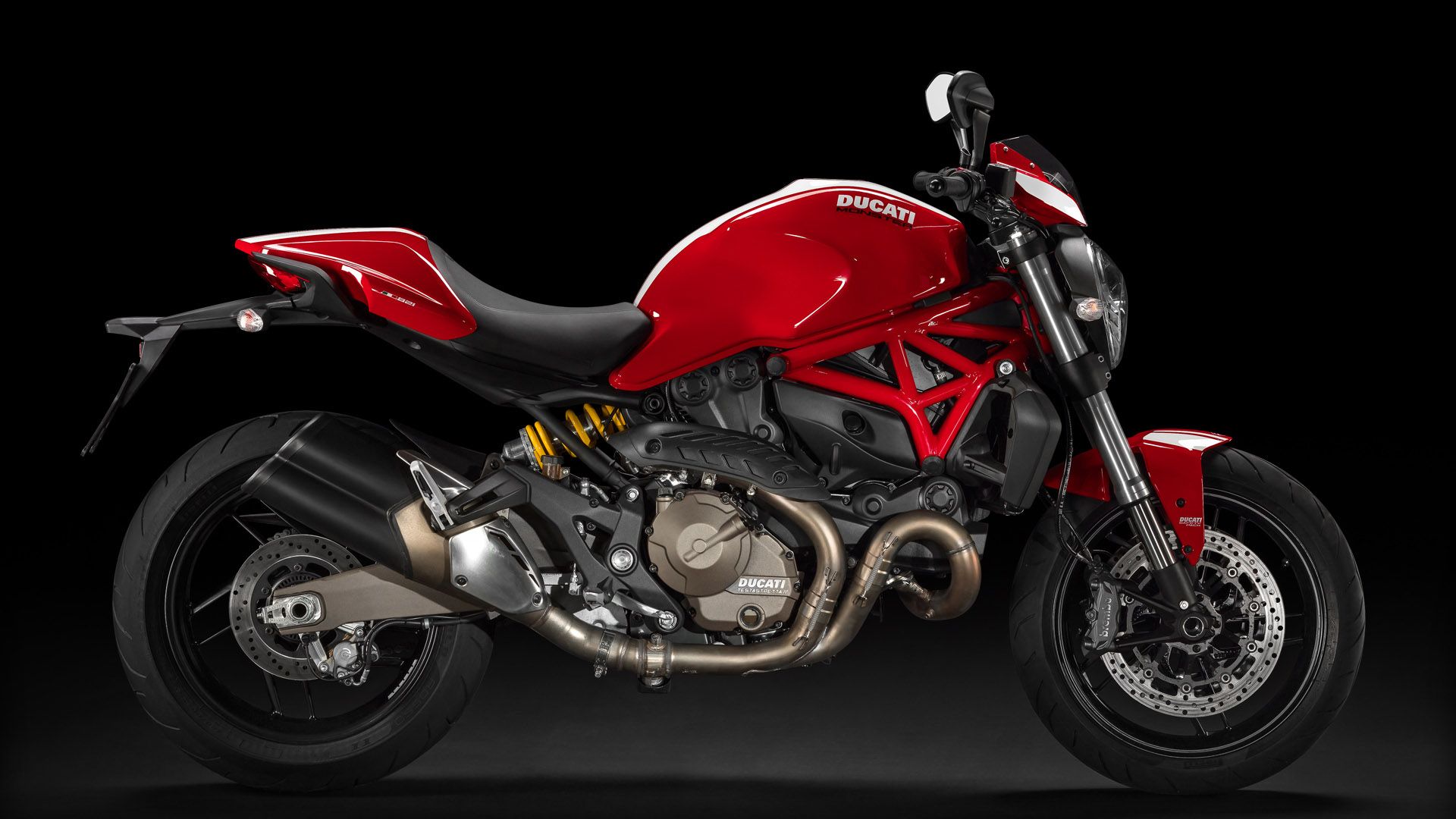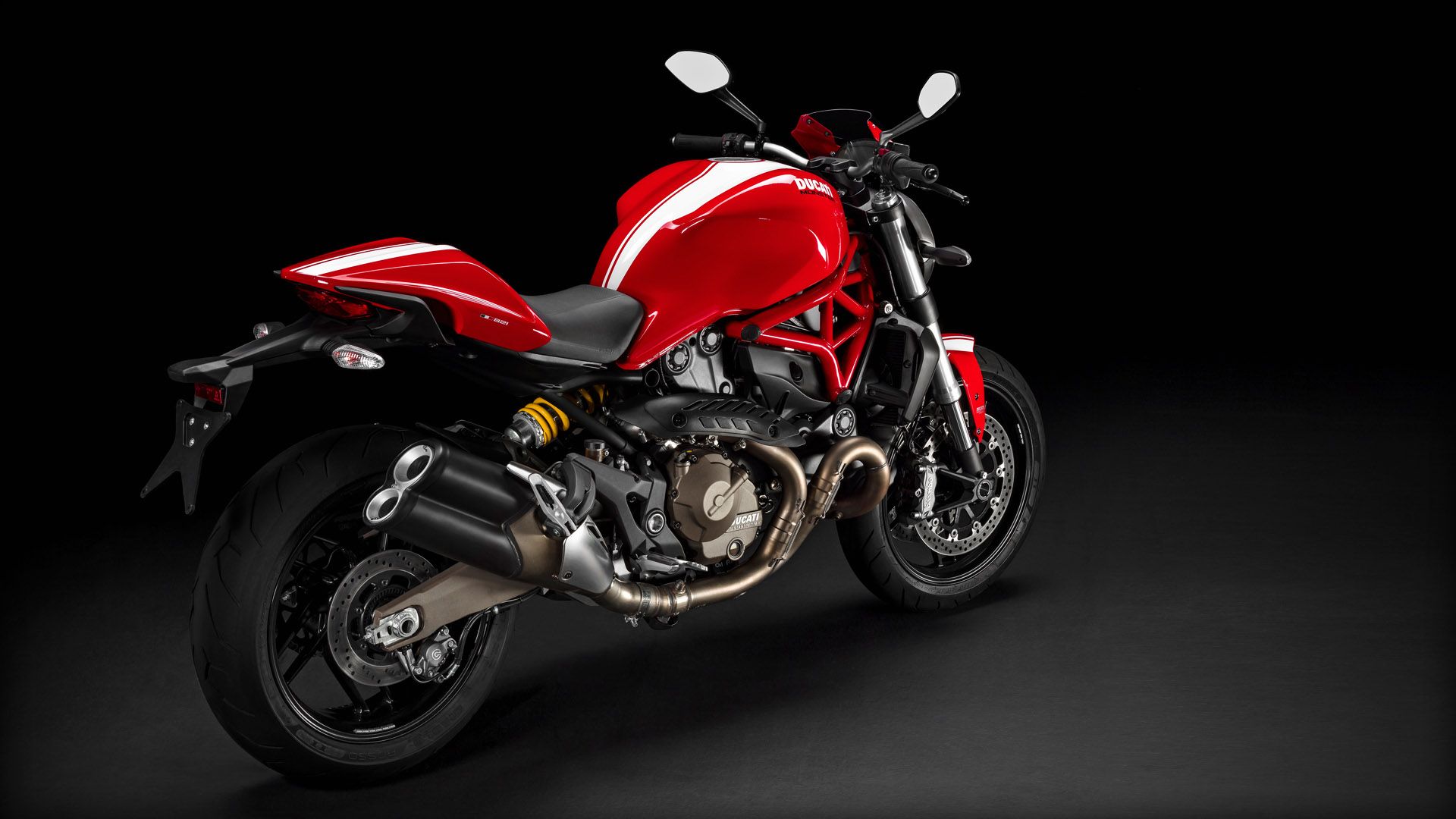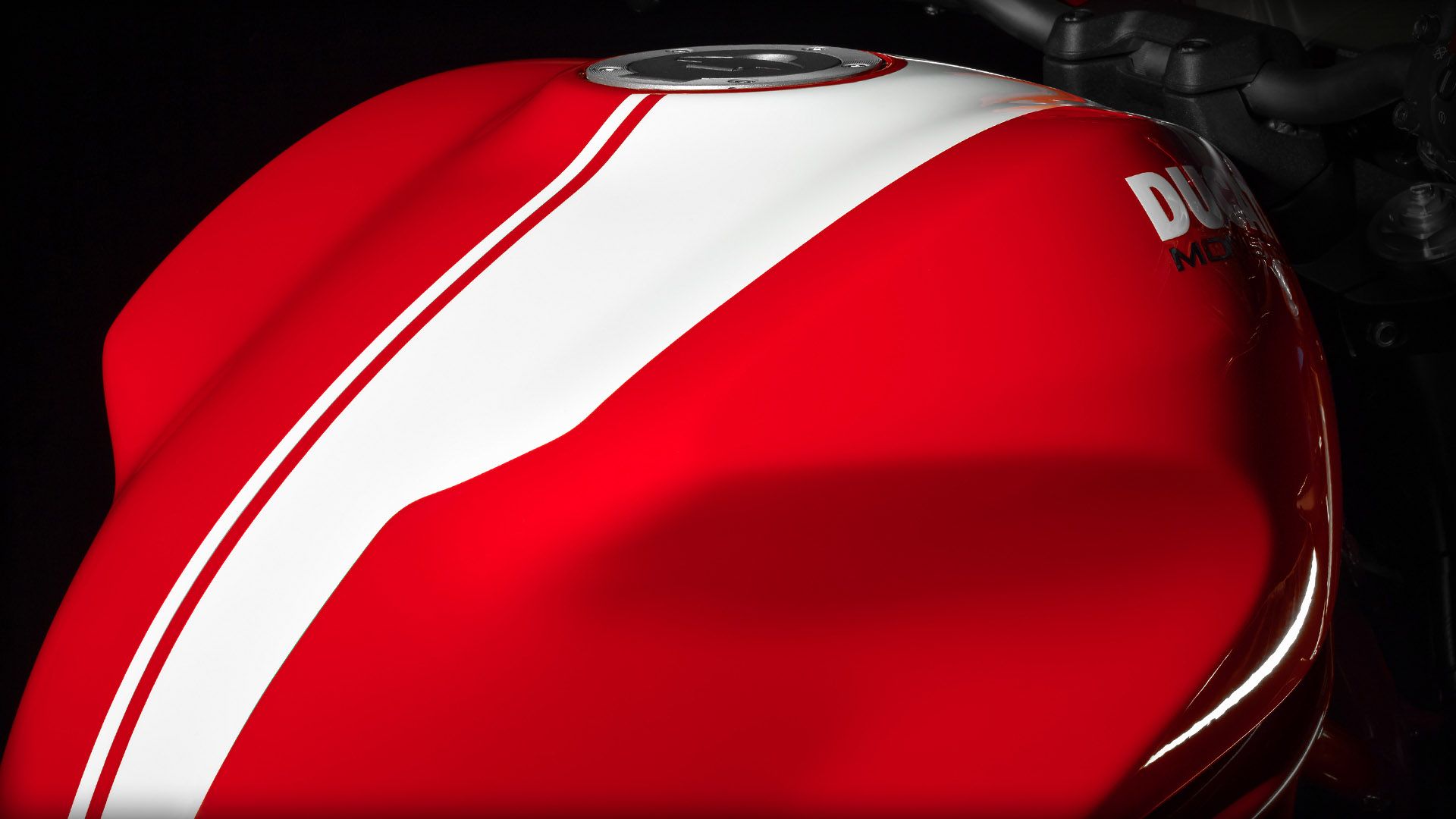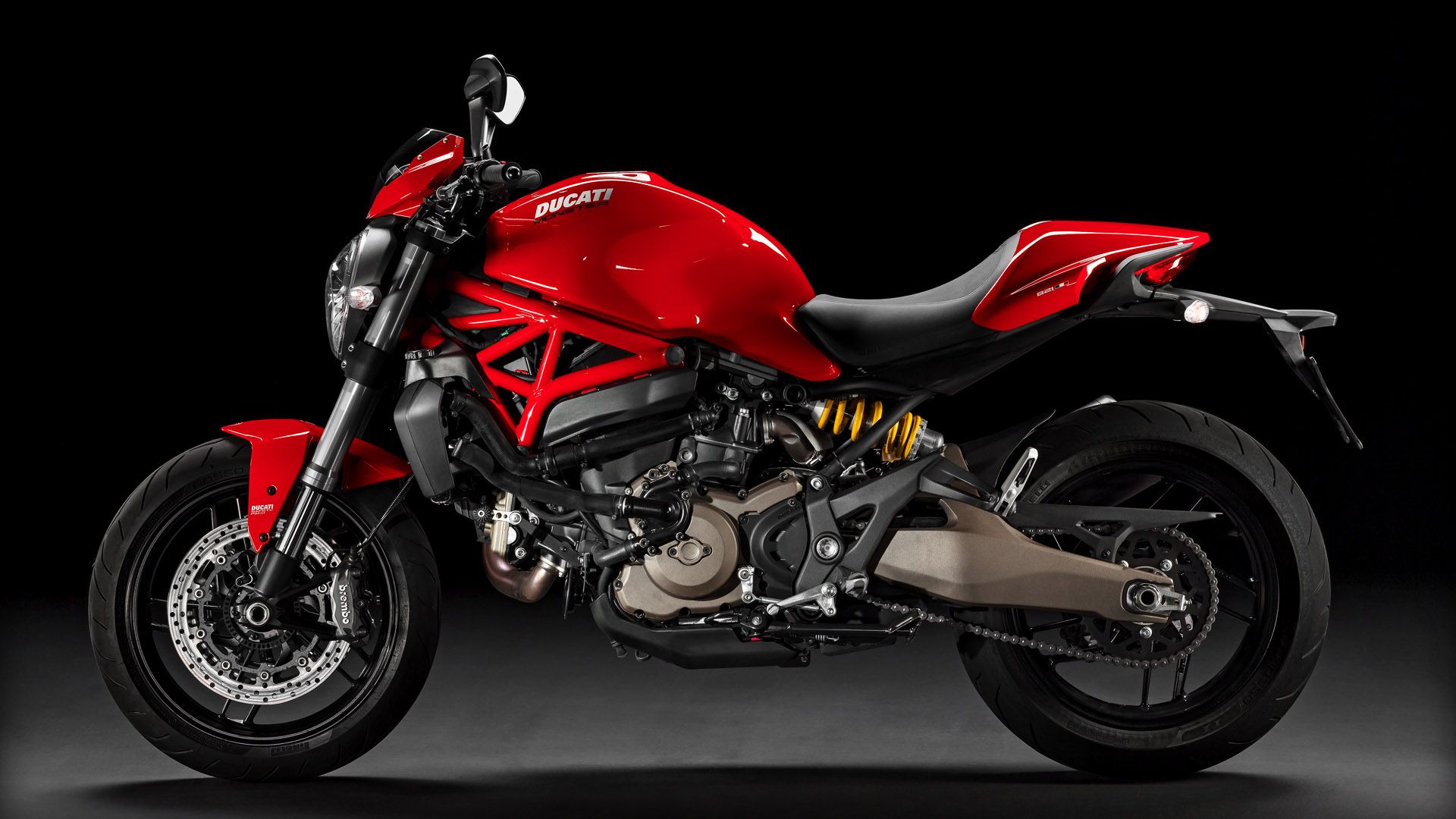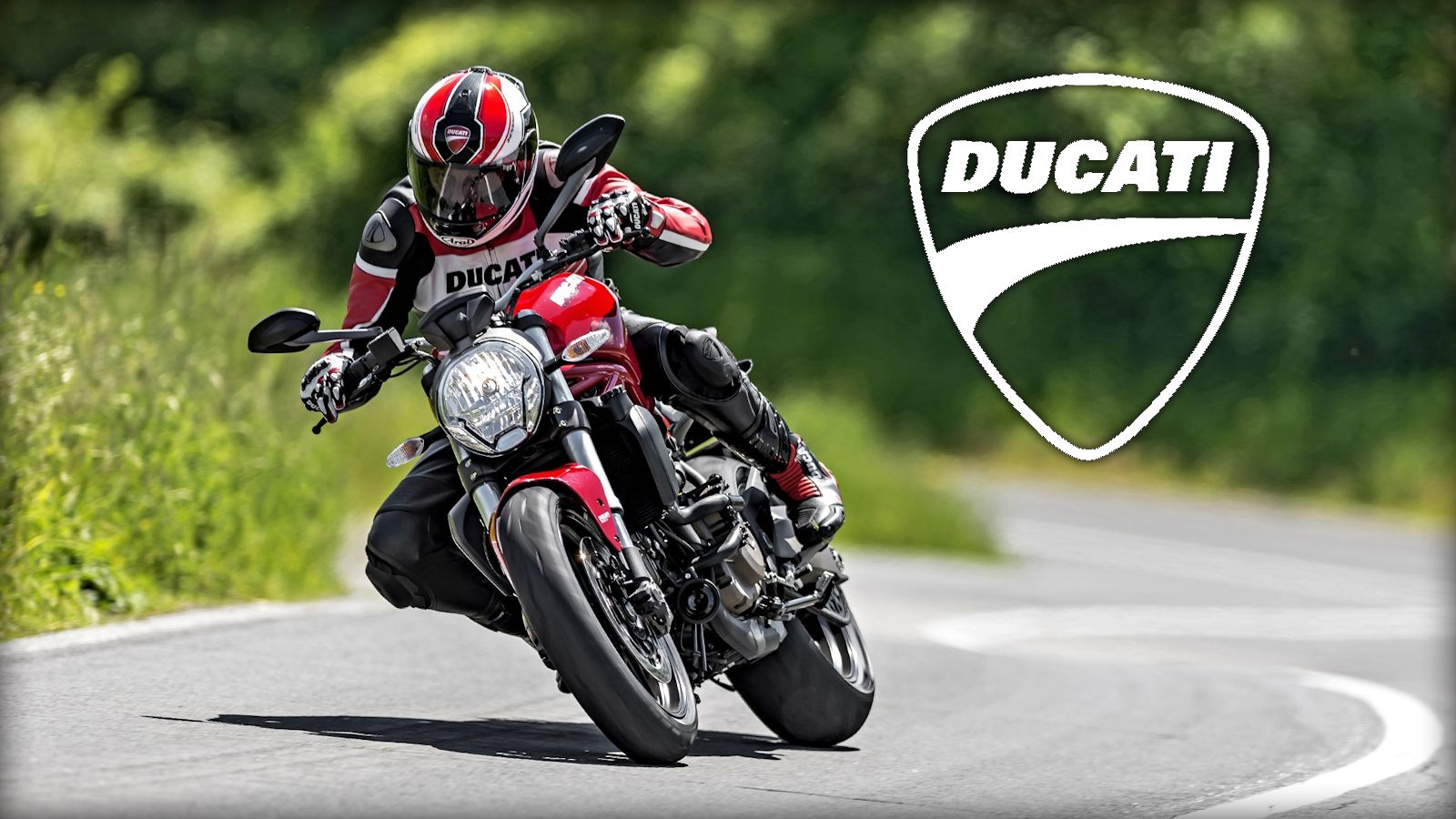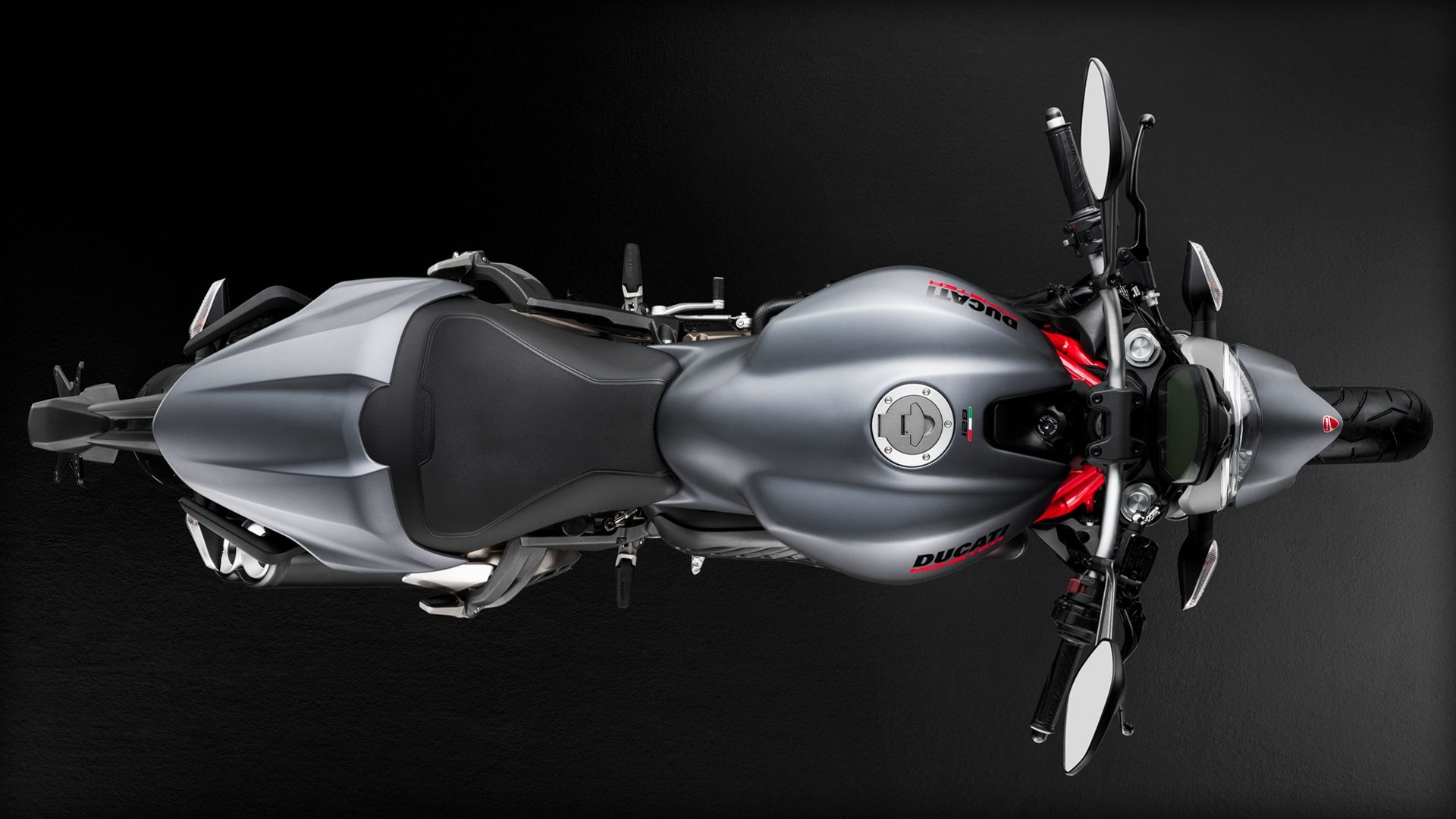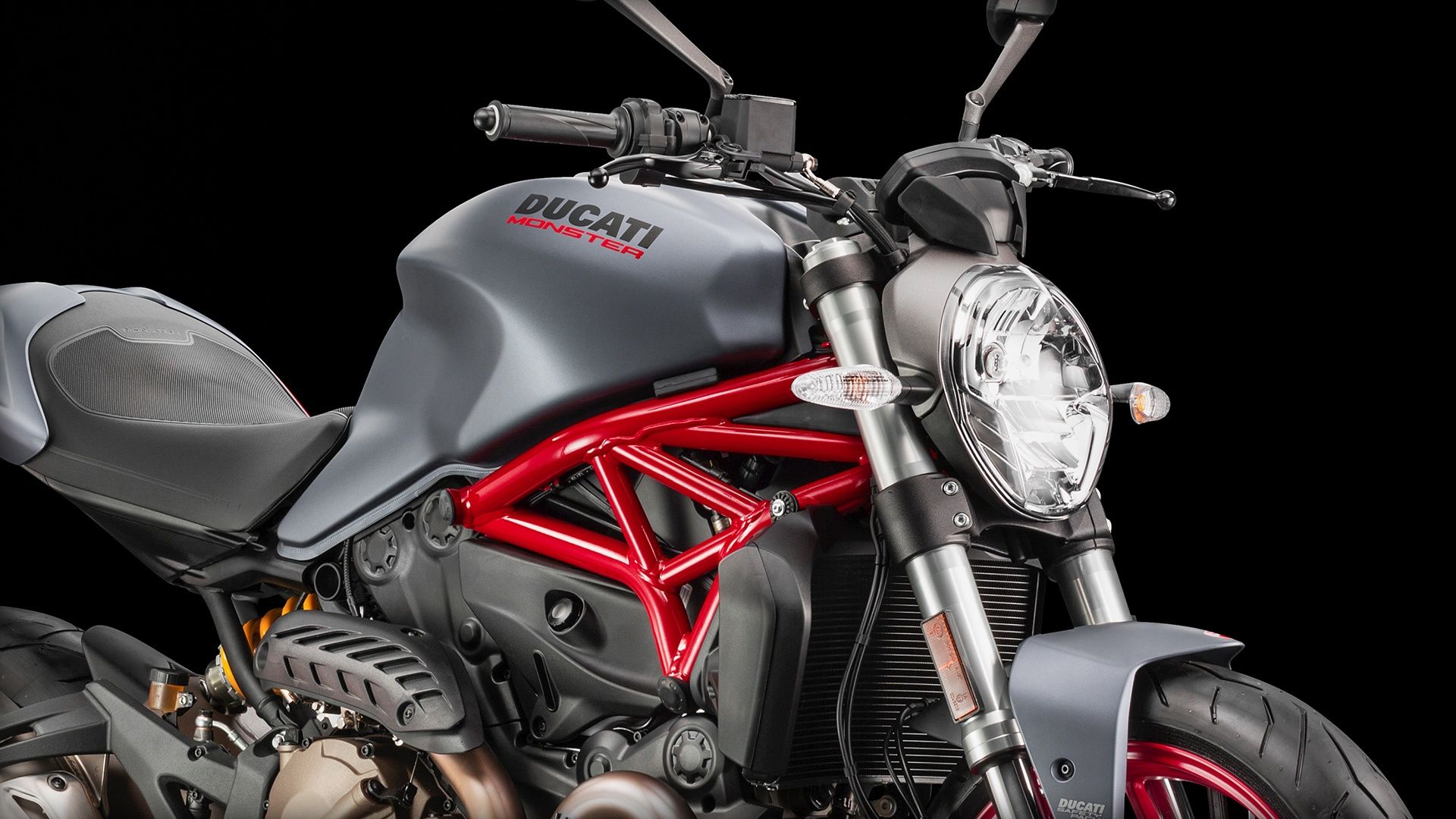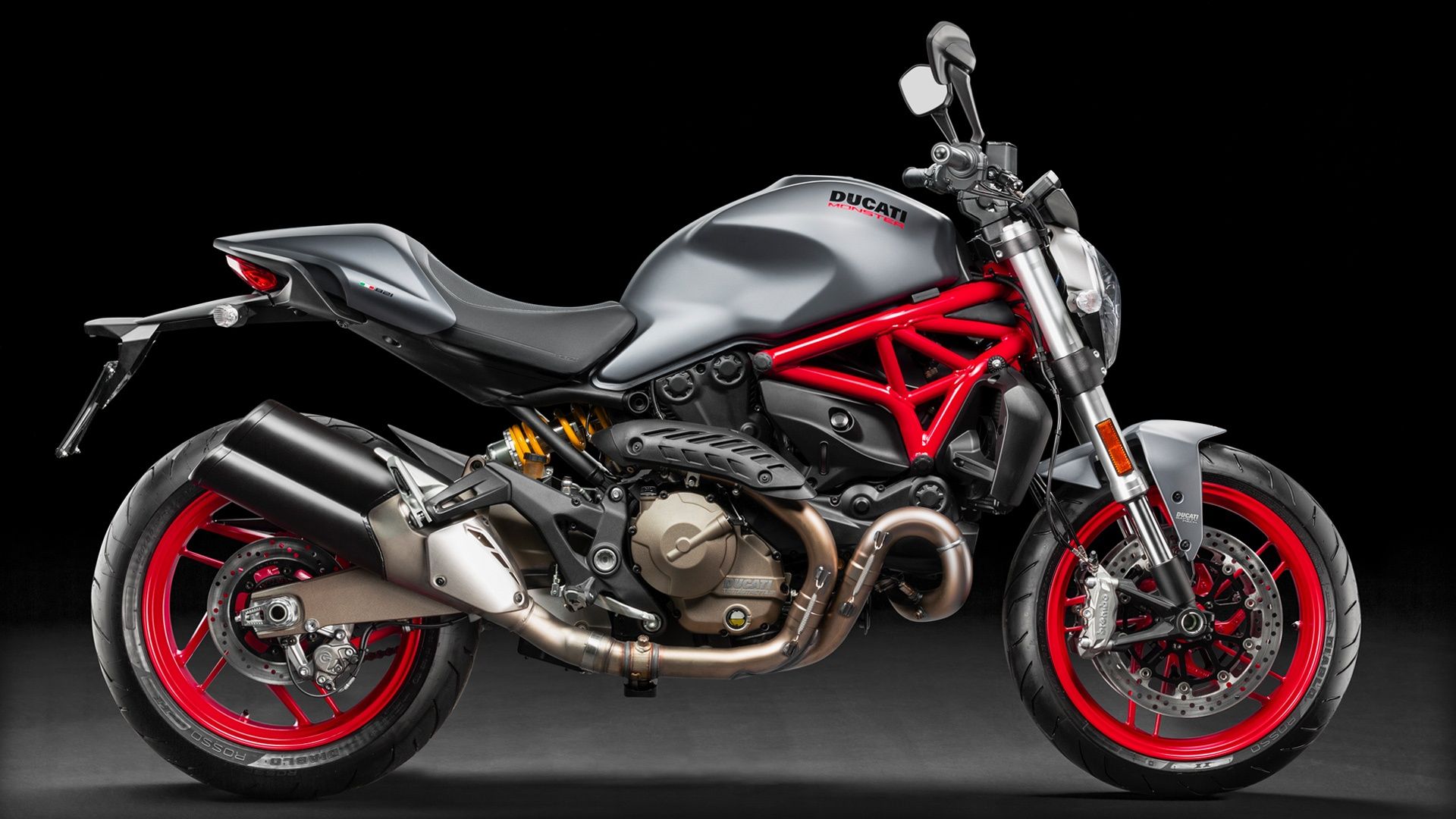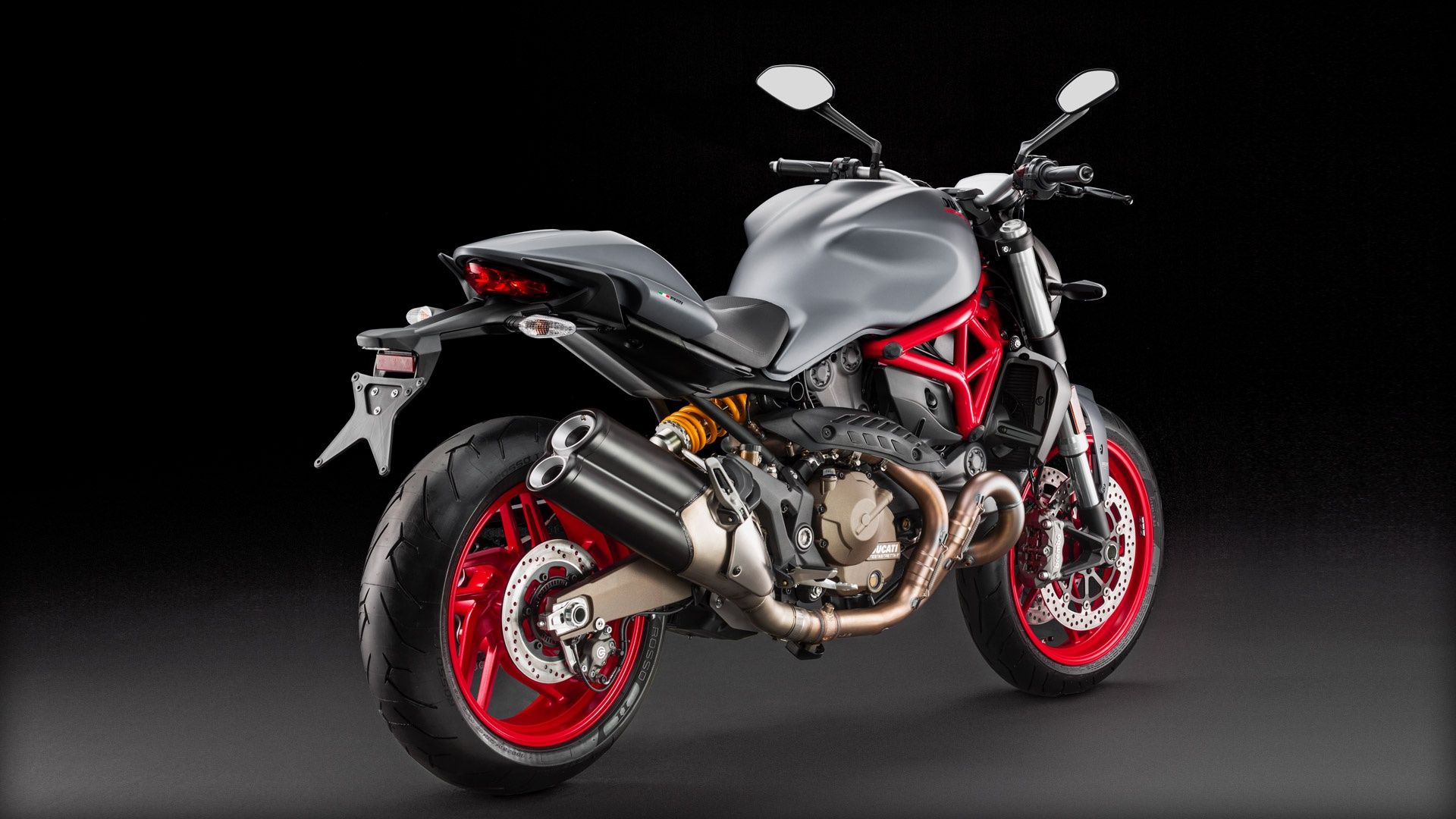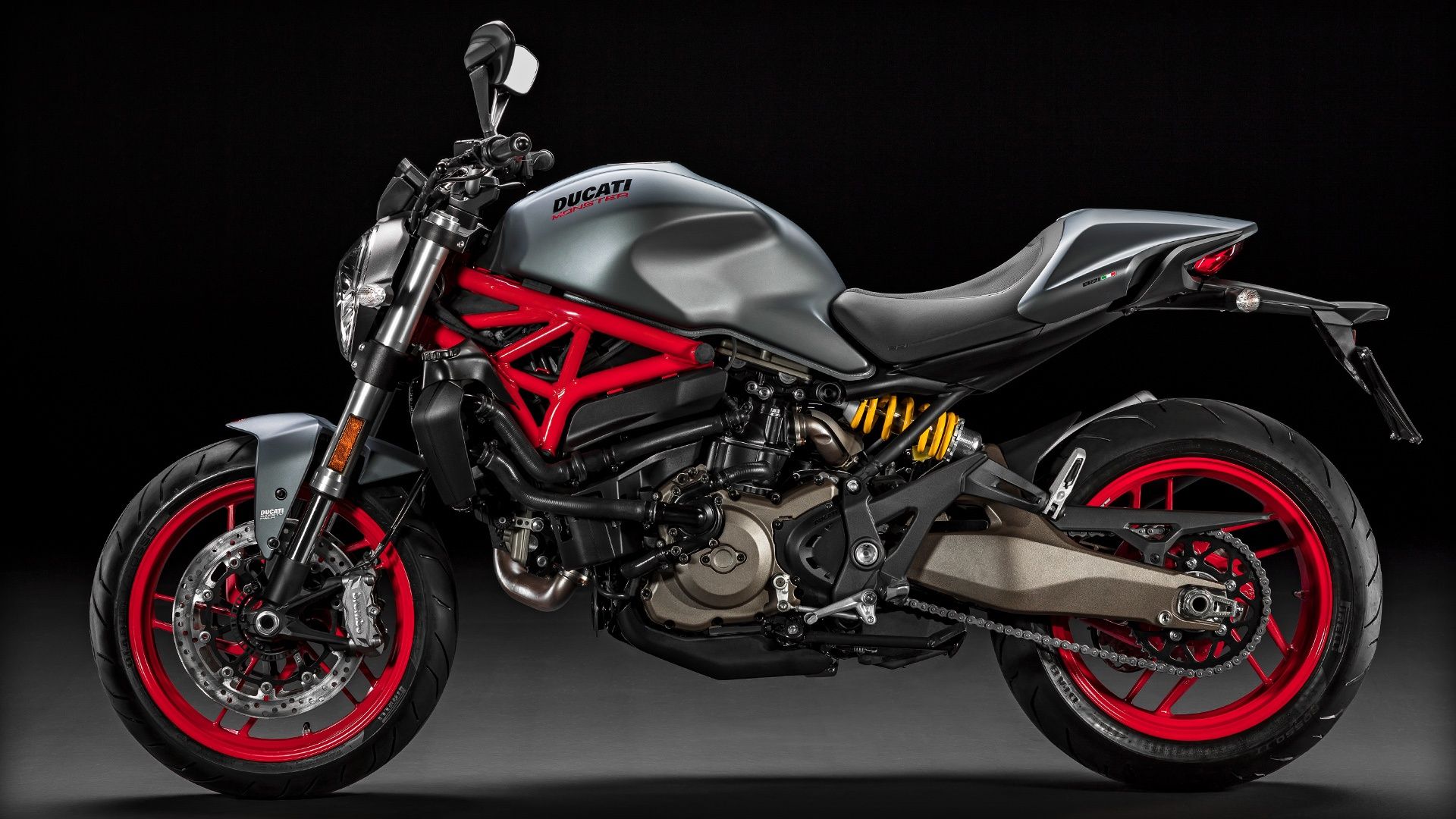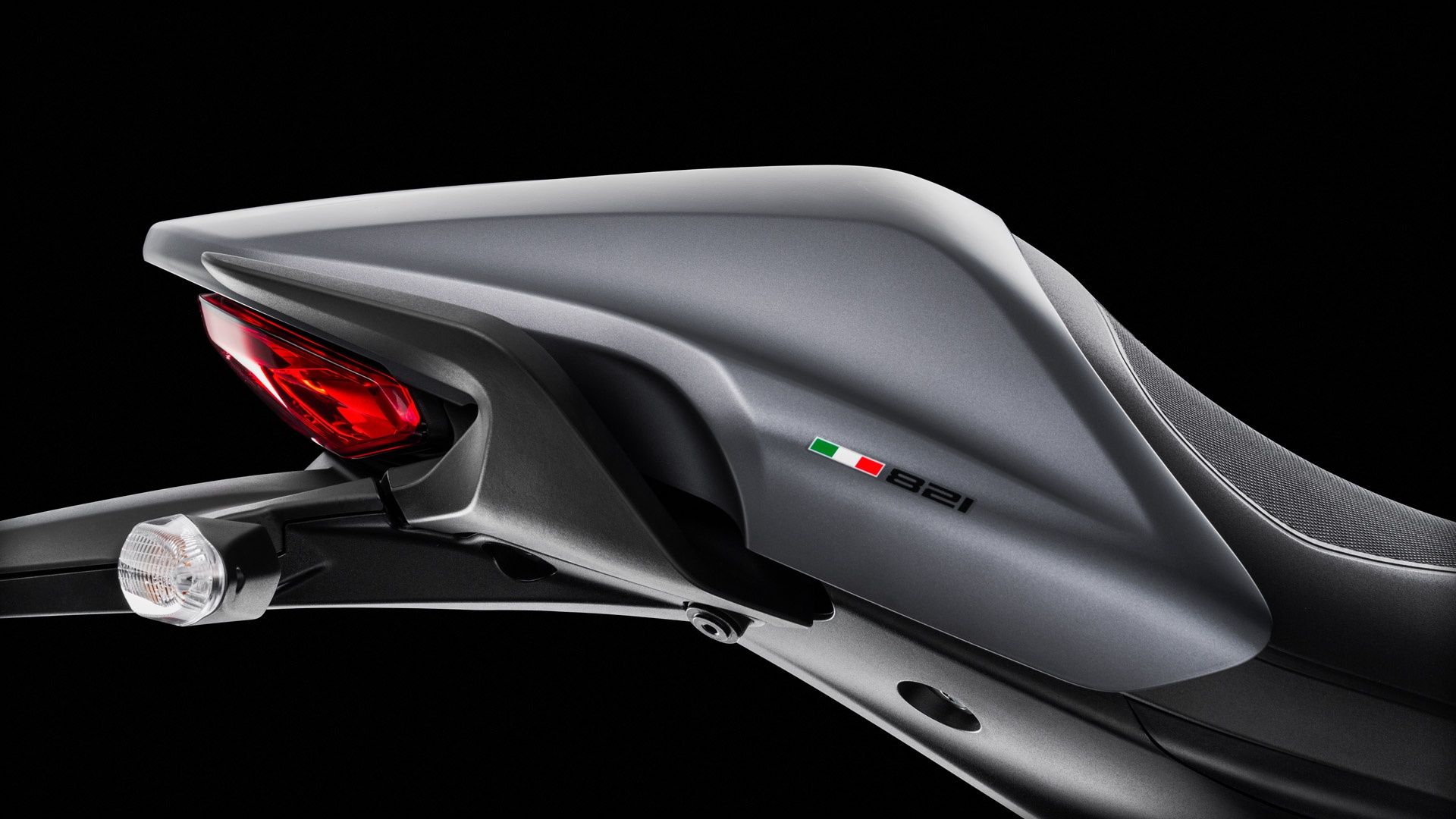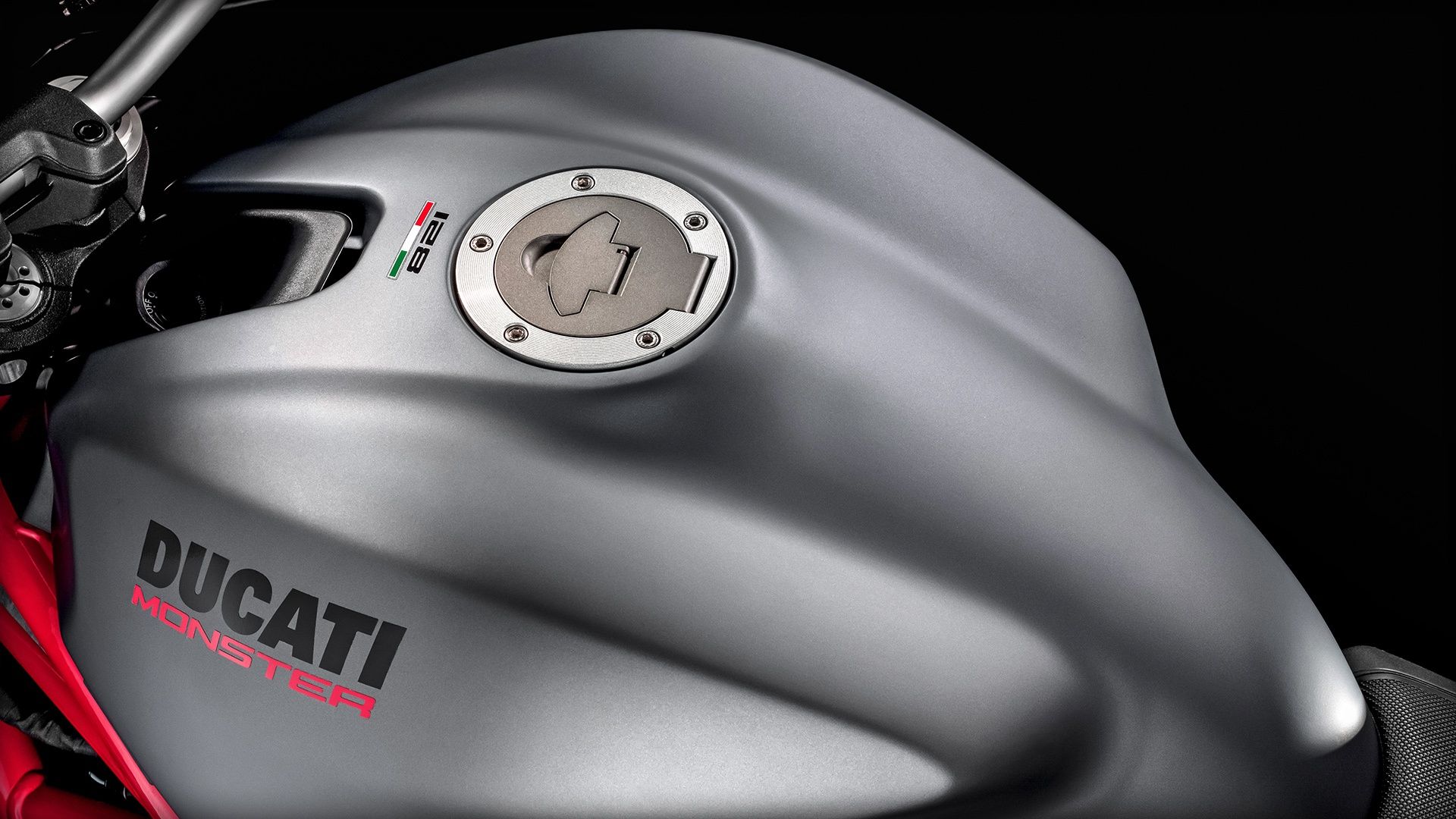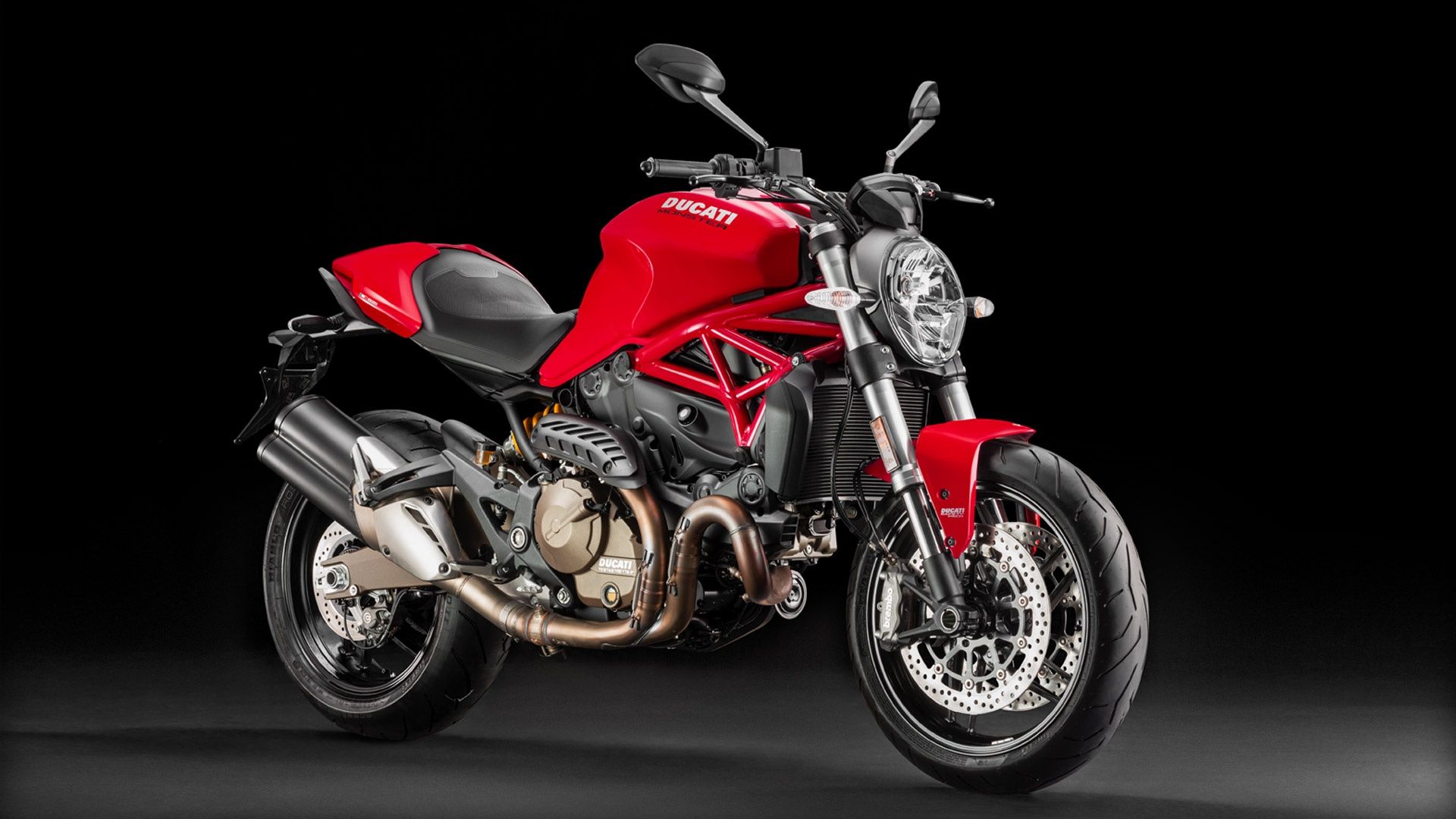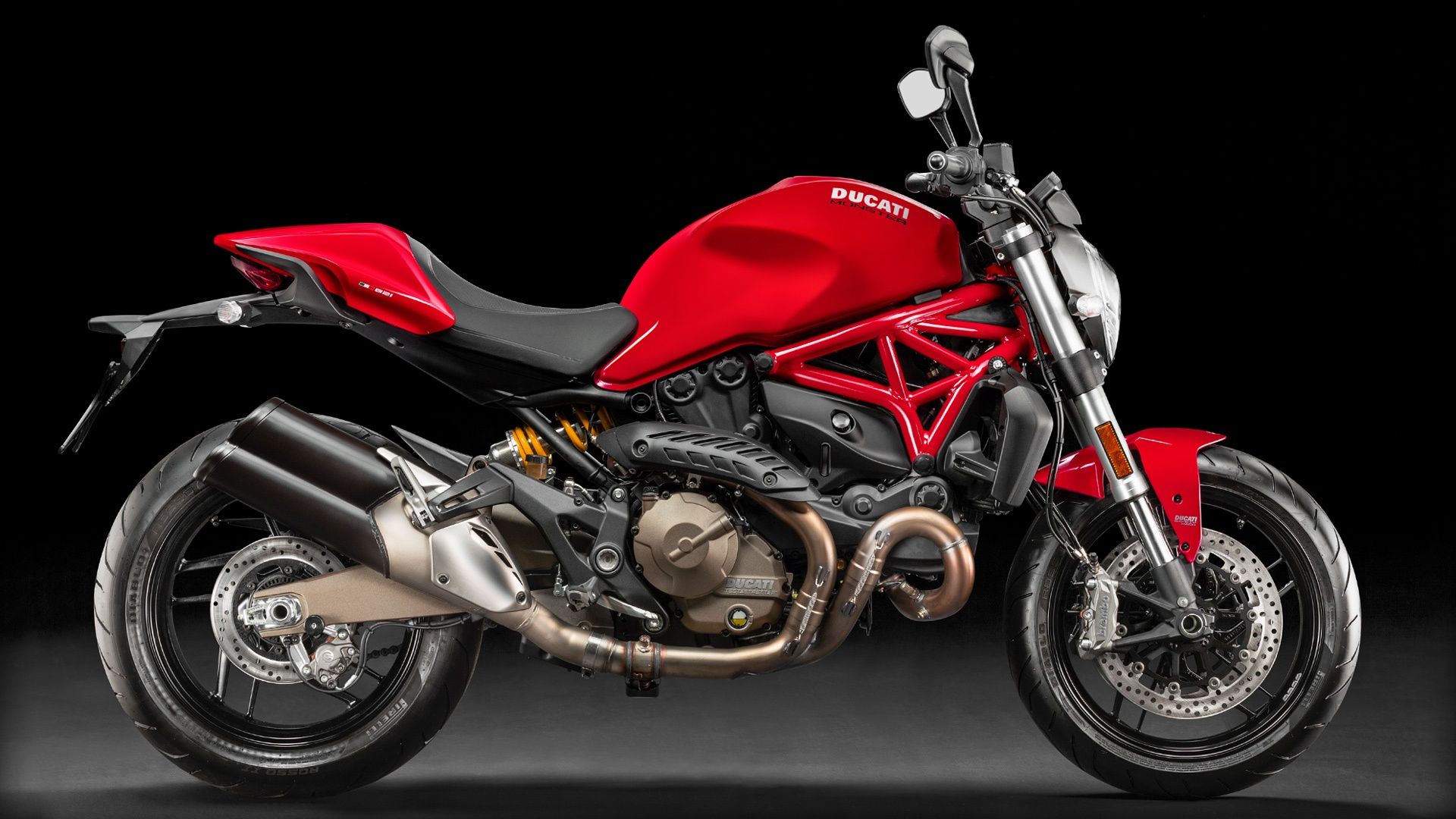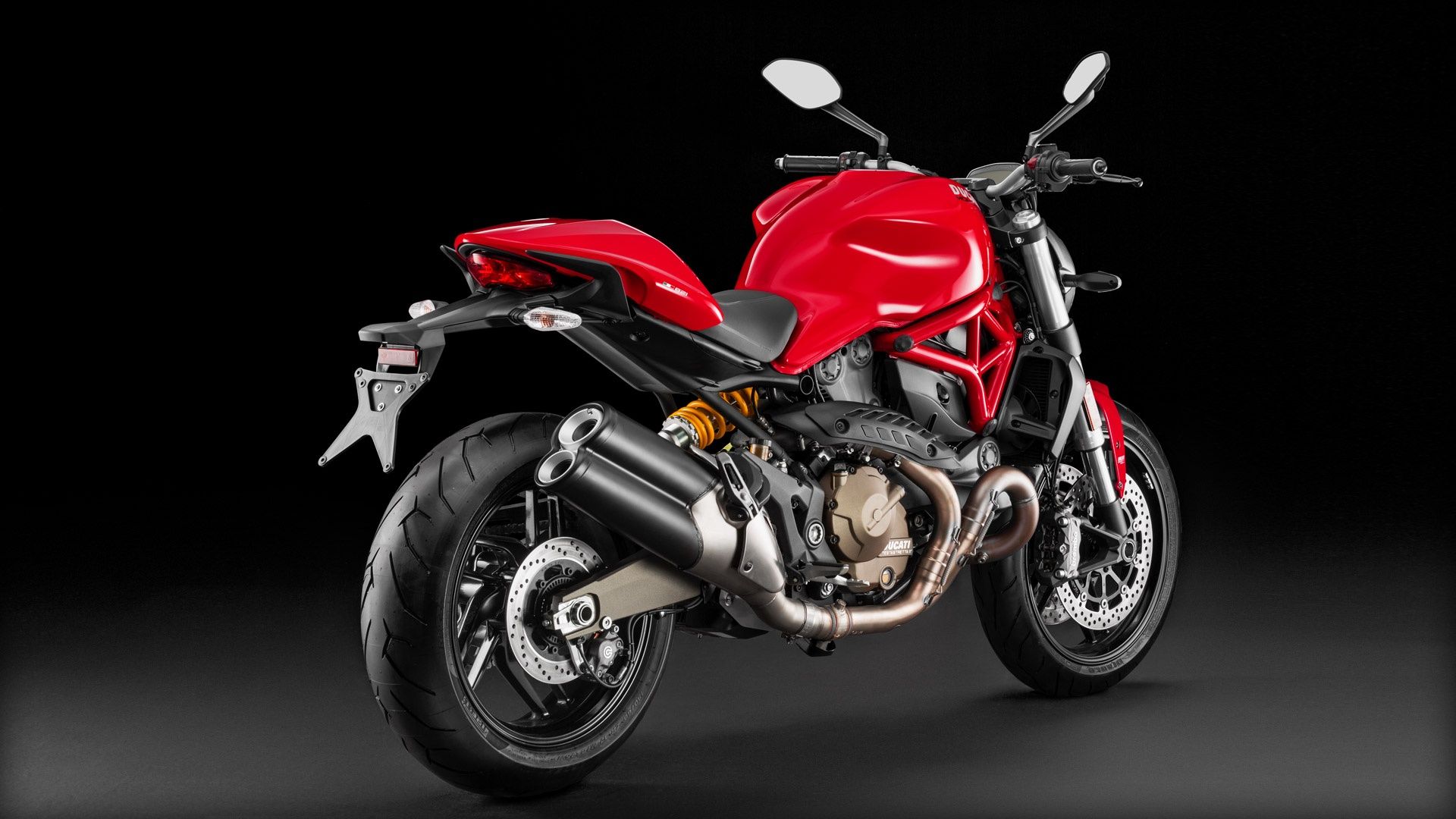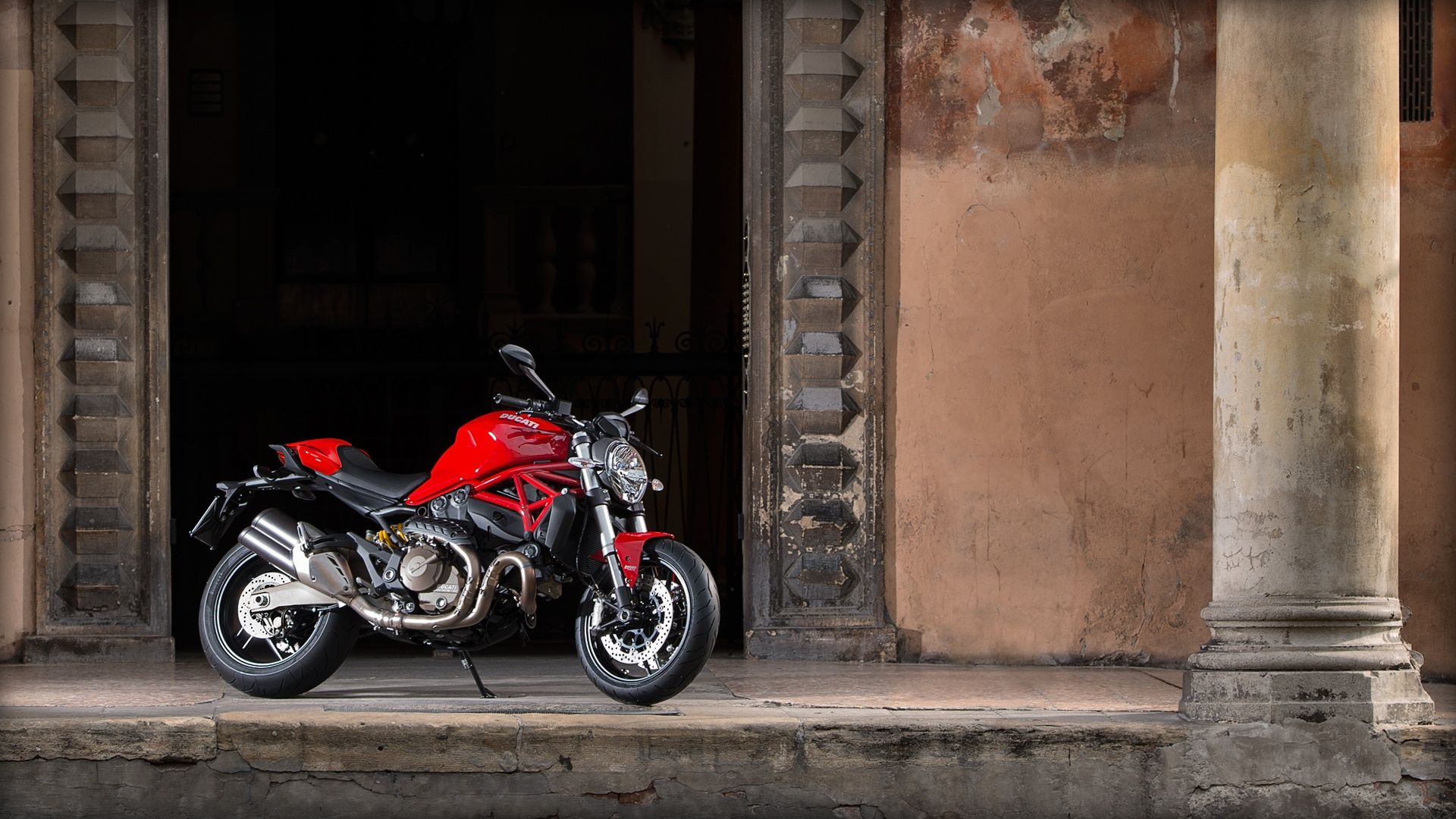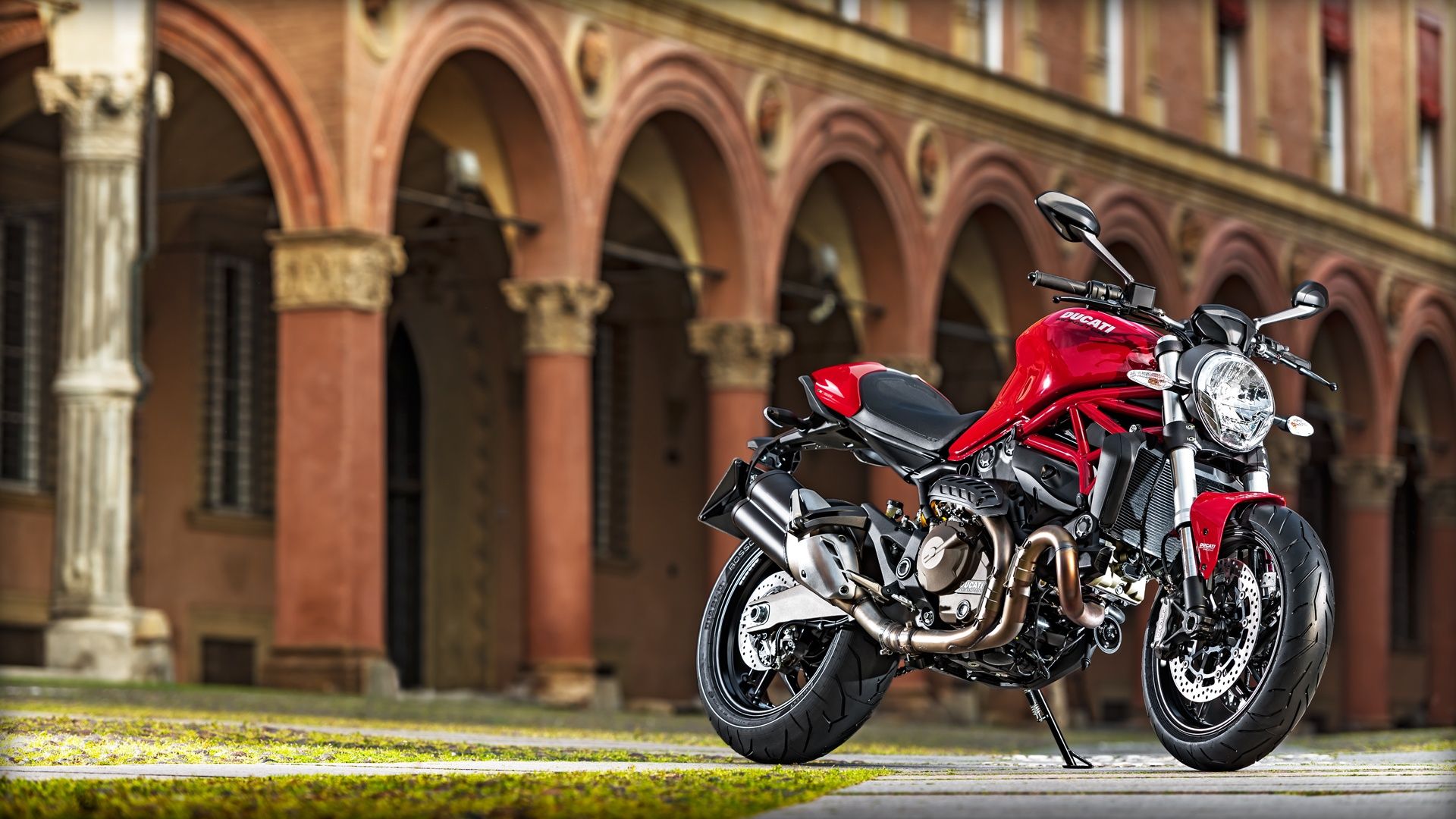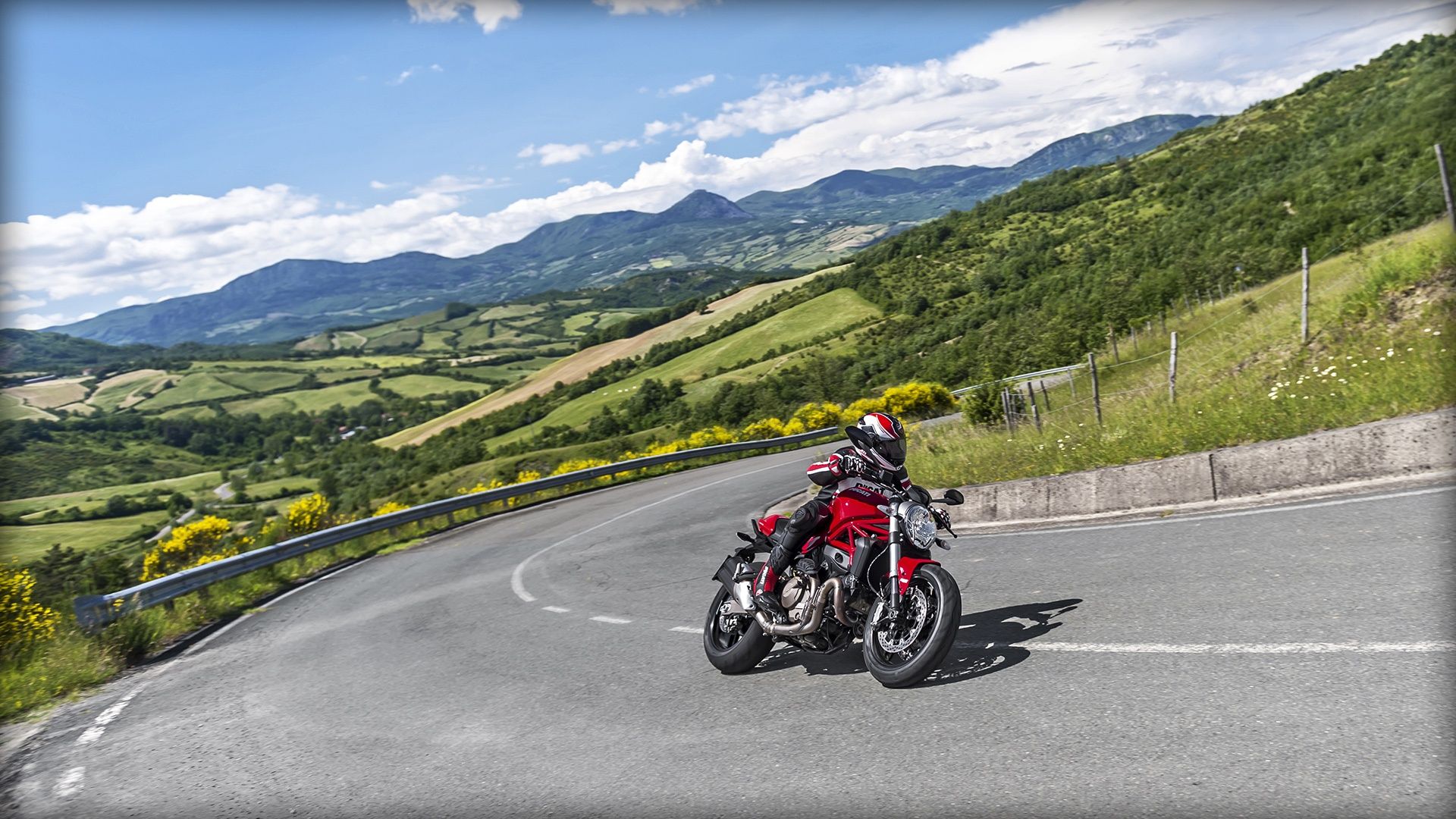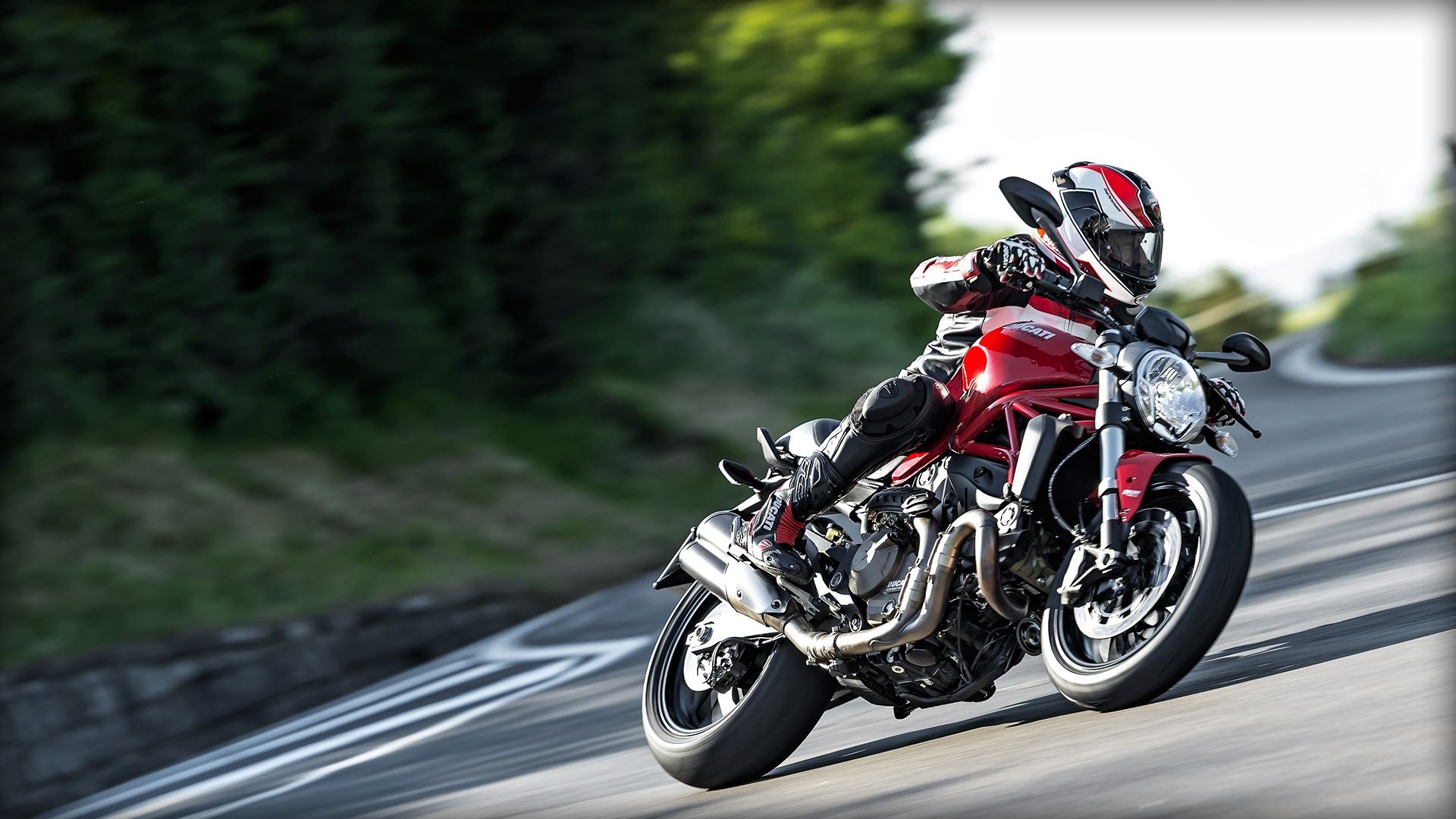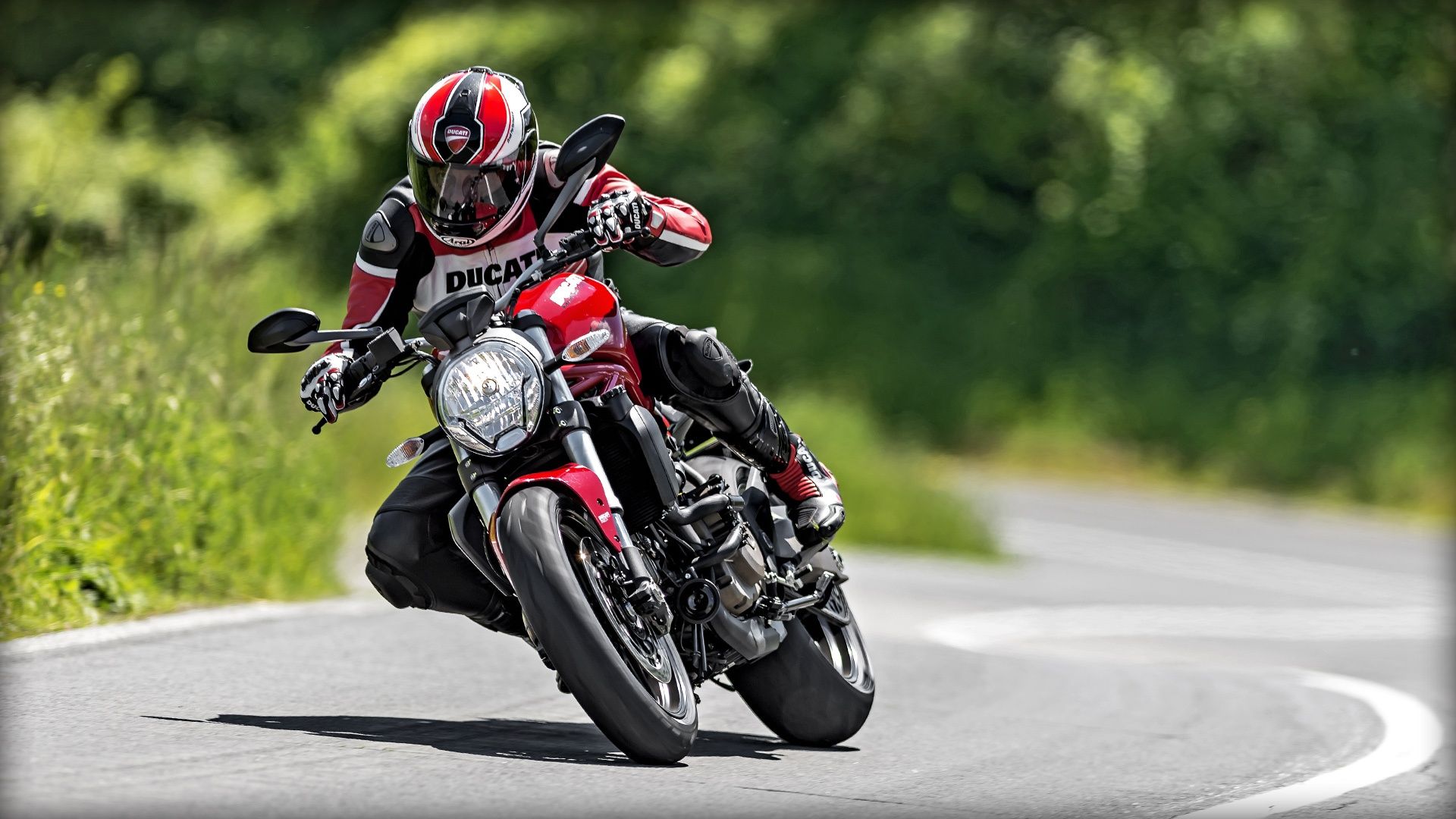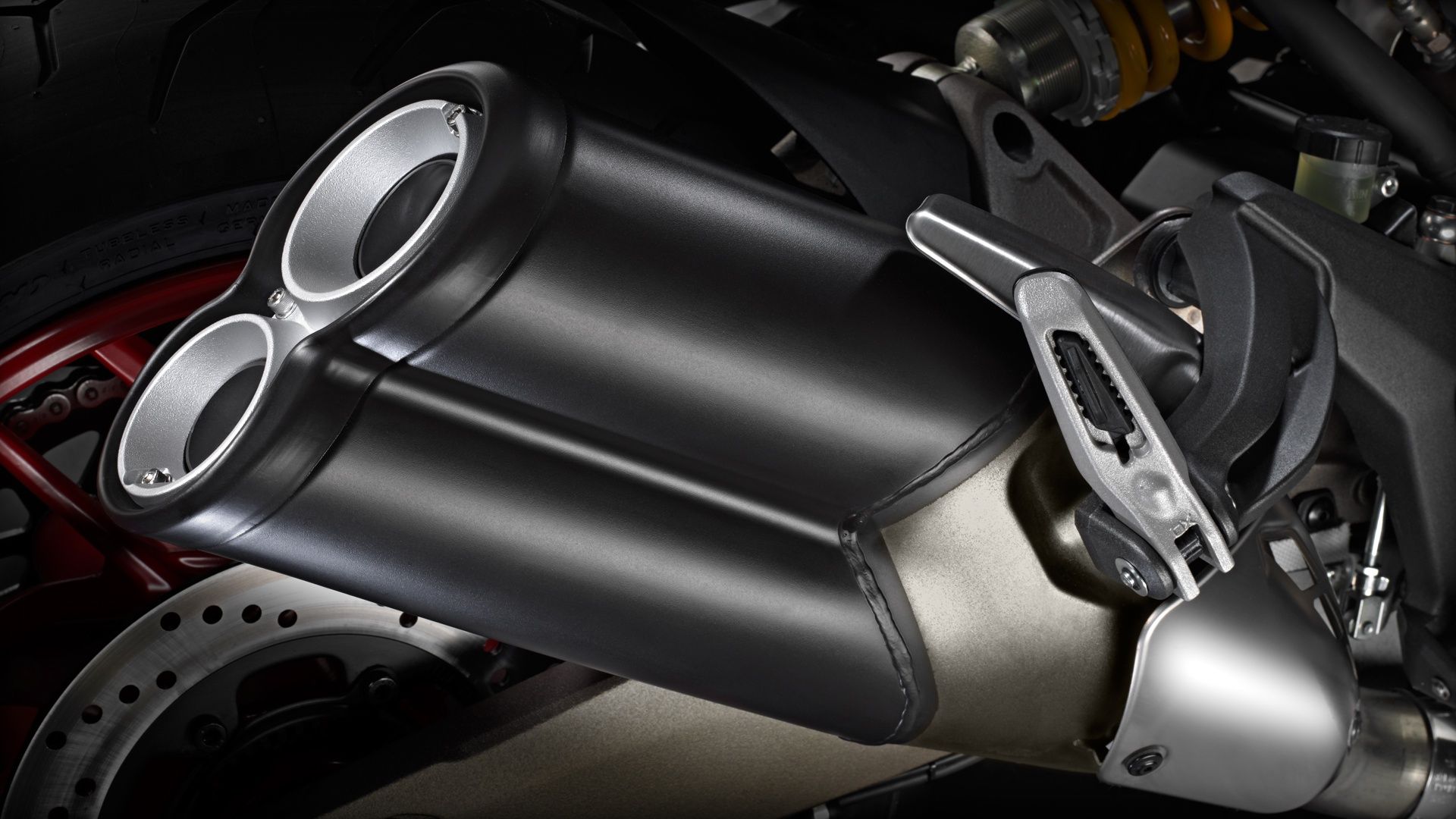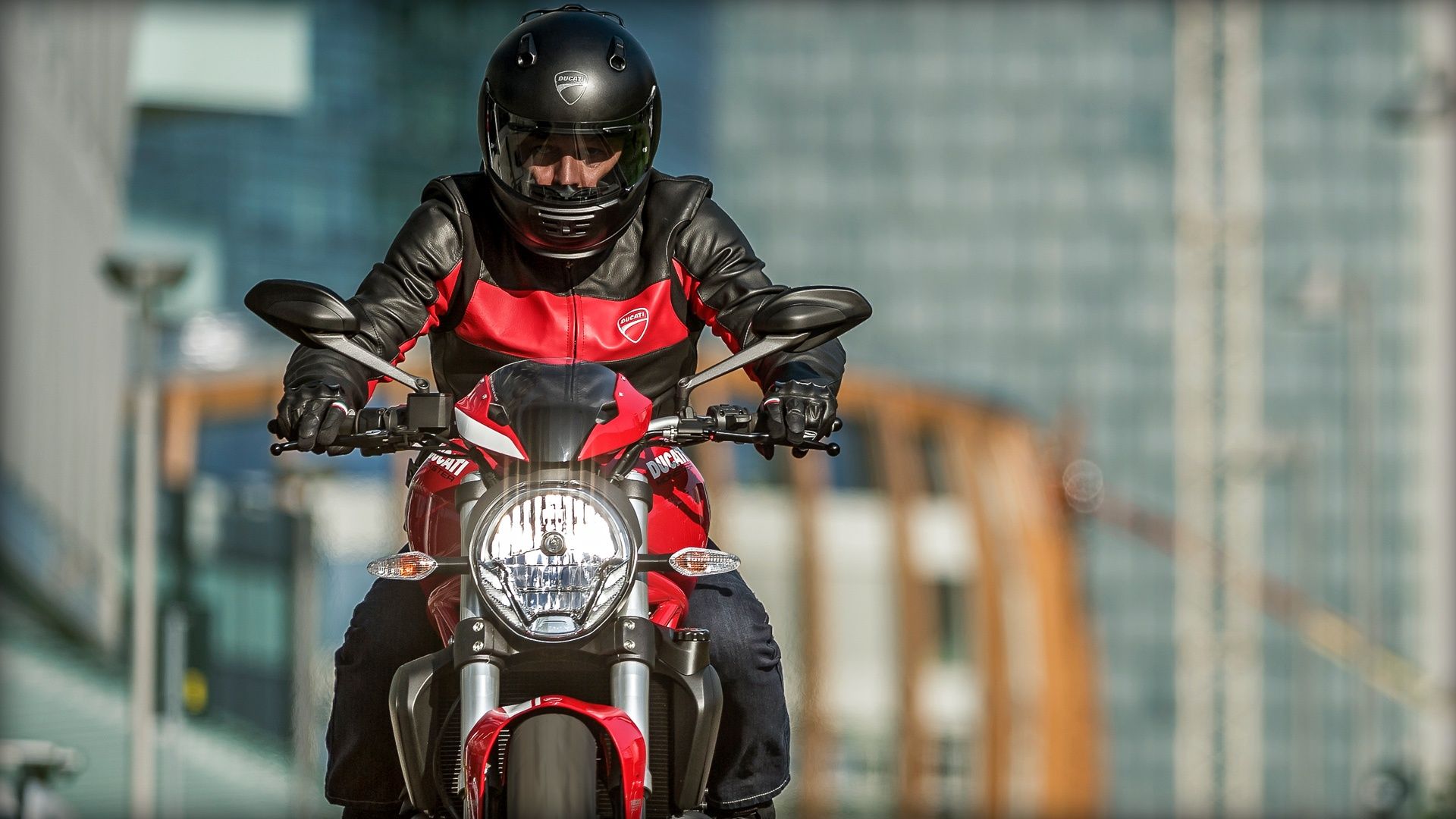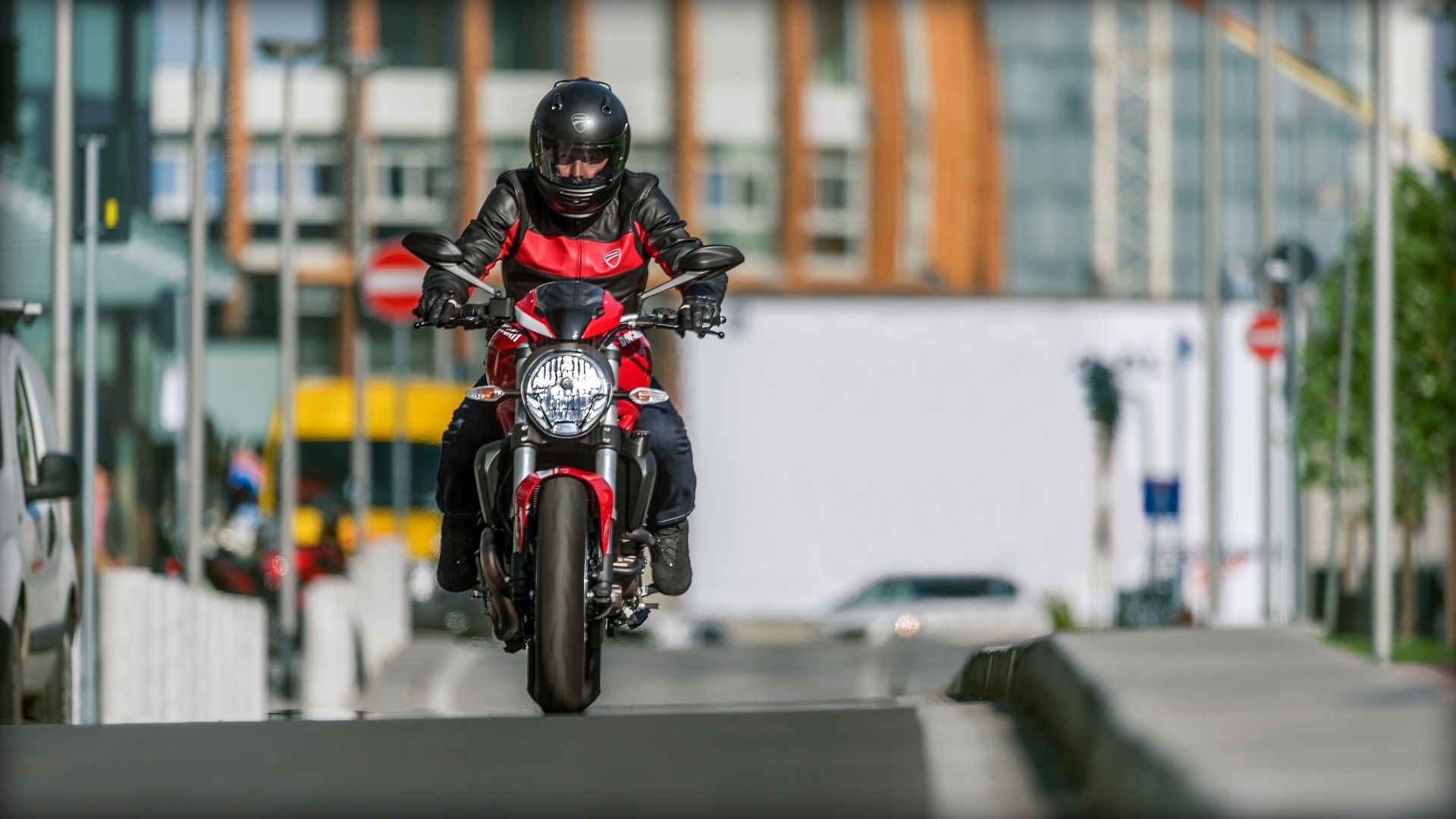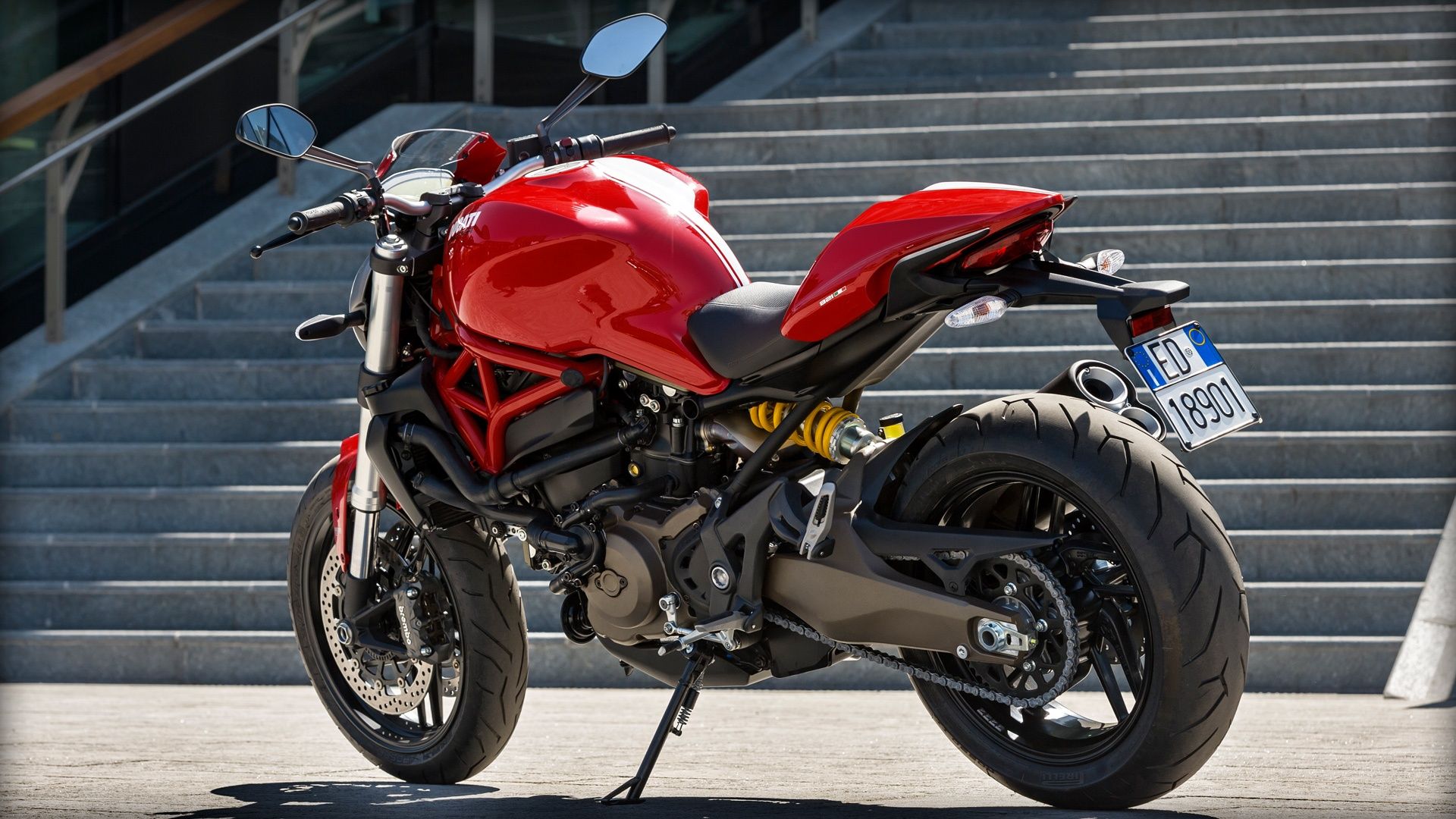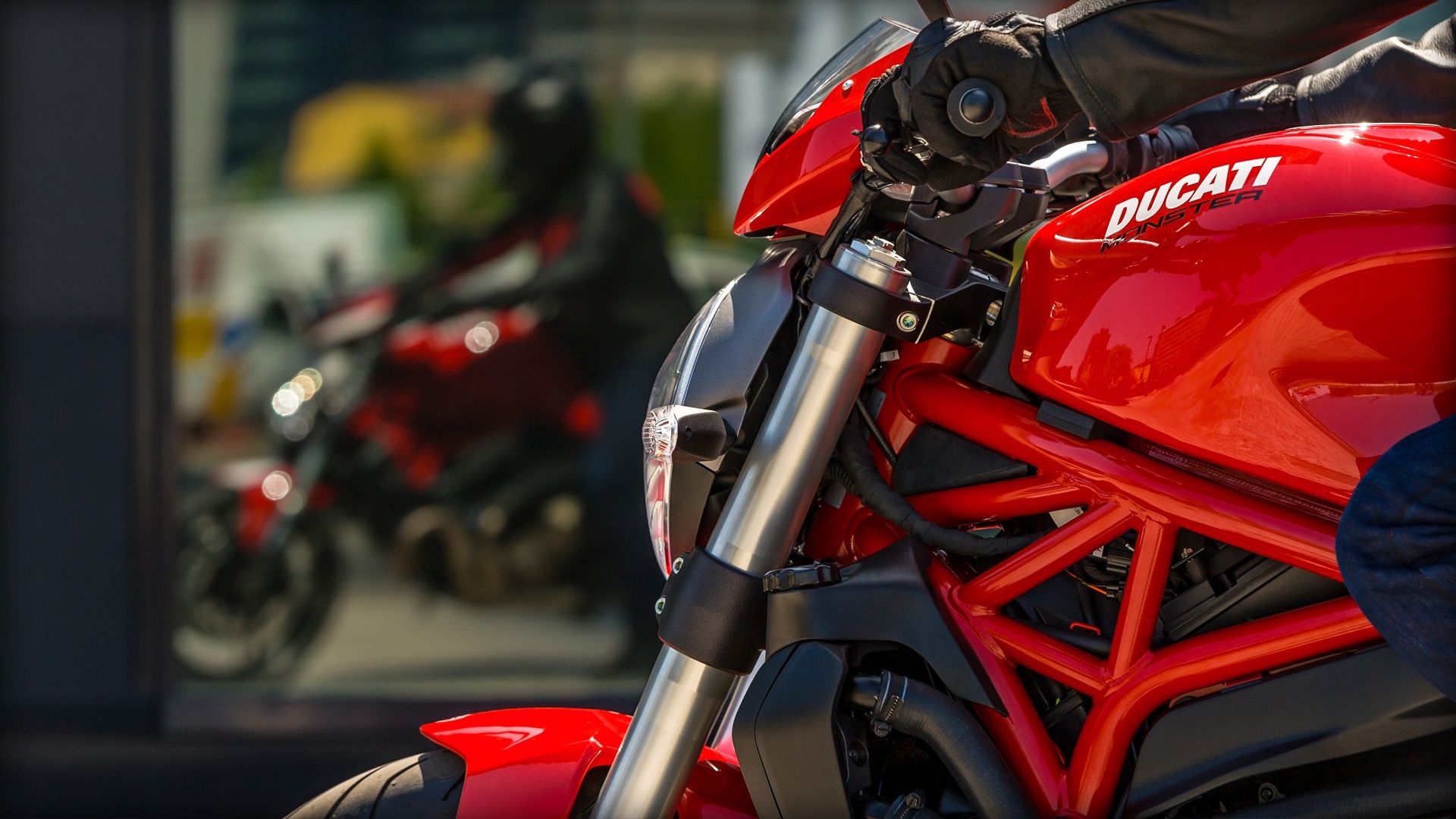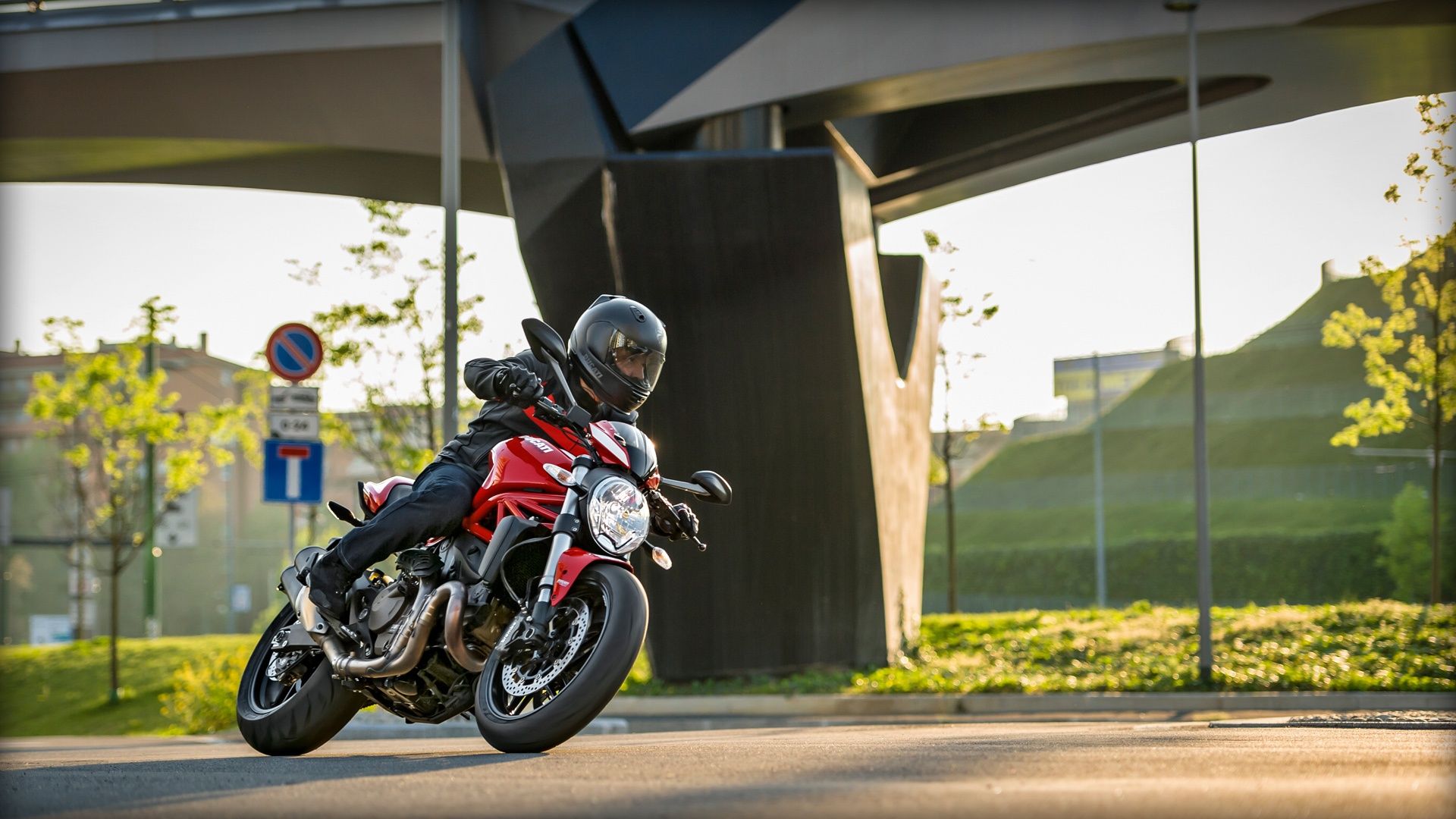What does you do when you have a powerful and popular naked sportbike such as the Monster 1200 and a smaller, simplified version of same with an 803 cc powerplant? You simply add a third model, according to Ducati. Introducing the stop-gap Monster 821 siblings. The base model carries many of the genetic markers associated with the Monster range with a 112-horsepower engine and host of electronic gadgets that never made it onto the entry-level 797 model. This plugs a significant gap in its naked Monster lineup and gives us an entry-friendly model with a taste of the refinement typically enjoyed on the larger-displacement rides. Ducati followed up with the race-tastic “Stripe” version that pulls adjustable front-suspension components off the top shelf for another layer of ride-quality control. Something for everyone? Perhaps not, but a damn good compromise between the existing models within the range in many ways.
Continue reading for my review of the Ducati Monster 821.
2015 - 2017 Ducati Monster 821
- Make: Array
- Model: 2015 - 2017 Ducati Monster 821
- Engine/Motor: Testastretta 11° L-Twin, 4 Desmodromically actuated valves per cylinder, liquid cooled
Design
Ducati stuck to the stance, tank shape and flylines that make the Monster 1200 so recognizable. A cut-down fender leads the way beneath a minimal headlight housing that contains bright hi- and low-beam bulbs with LED marker lights and turn signals. The plane of the headlight flows into the backside of the instrument panel to form a sort-of vestigial flyscreen.
Inverted forks and exposed frame members lend the front end a beefy industrial look ahead of the distinctively-molded fuel tank. The stock saddle can be adjusted to meet the rider's butt anywhere between 30.9 inches and 31.8 inches off the ground, and the factory offers a range of seats that can get as low as 29.3 inches high for the vertically-challenged riders out there. Most riders will be able to strike a fairly upright riding posture, but the short bars are going to strongly encourage a more aggressive pose.
A small fairing conceals the wide pillion area of the seat when it's not in use, but when you do need to carry a passenger there's a set of flip-out footpegs and oh-shit handles to help keep them on the bike. Naturally, this comes with the sensual curves one expects from an Italian streetbike in spite of its general lack of body panels. In other words, just exactly what one expects from Ducati.
Chassis
The Monster's race-inspired frame pushes the stressed-engine concept to the limit with all parts of the frame/subframe, as well as the rear suspension, bolted up to the drivetrain. Up front, a few patches of Trellis-type webbing locks the steering head in at 24.3 degrees with 3.7 inches of trail; numbers that give the Monster 821 some very responsive handling that is really quite eager in the corners.
Rather than trying to be edgy or cute, the factory opted for a confidence-inspiring, two-sided swingarm that looks like it can get the job done safely. Both the base model and the Stripe sport inverted, 43 mm front forks, but while the base model stems are pure vanilla, the Stripe boasts adjustable rebound damping as well as variable spring preload.
Out back, the Sachs monoshock provides the same level of adjustment to both models. A pair of 17-inch, ten-spoke cast-alloy rims round out the rolling chassis with hoops that are commensurate with the 821's capacity for sporty riding. Pirelli's Diablo Rosso II tires come with the proprietary Enhanced Patch Technology and Functional Groove Design needed to safely transmit the power to the pavement, even in wet conditions.
We find our first bit of gadgetry in the anchors. First, the mundane; a pair of four-pot, Brembo Monobloc M4-32 calipers bite dual 320 mm front discs with a twin-pot caliper and 240 mm disc to control the rear. All of that is fairly typical fare nowadays, but Ducati sweetened the deal with the Bosch 9MP ABS that monitors brake pressure and provides three levels of intervention so you can dial in for the conditions and/or your skill level.
Stoppies ain't your thing? There's a setting to prevent them. Stoppies make you hot? There's a setting for that, too. Don't want ABS at all? Switch it off at any time. This flexibility in the brakes is just one of the features that makes this bike appeal to such a broad range of riders, and it comes bundled with the traction-control feature in Ducati's Safety Pack. At the end of the day, the front brakes are strong and dependable, but the rear feels a little vague, but that's OK since 70% of your stopping power is up front anyway.
|
Frame: |
Tubular steel Trellis frame attached to the cylinders head |
|
Front suspension: |
Upside down 43mm forks (Stripe: fully adjustable) |
|
Rear suspension: |
Progressive linkage with adjustable monoshock. Aluminum double-sided swingarm |
|
Front brake: |
2 x 320mm semi-floating discs, radially mounted Monobloc Brembo M4-32 calipers, 4-pistons, axial pump with ABS as standard |
|
Rear brake: |
245mm disc, 2-piston floating caliper with ABS as standard equipment |
|
Instrumentation: |
LCD display |
Drivetrain
The DTC serves to provide another layer of safety and flexibility with a total of eight profiles for variable levels of intervention. It works with the ride-by-wire throttle to reduce power in order to restore traction if the rear end breaks loose, and much like the ABS feature, it can be turned off in its entirety for relatively raw throttle control. I say “relatively” because it's still an RbW system that treats throttle setting at the grip as more of a guideline than an actual rule for seamless transitions through the rpm range. It also comes with three separate power-delivery modes that let's you tailor for power-curve preferences and can even restrict output to 75 horsepower, down from 109 ponies at 9,250 rpm. Torque output maxxes out at 7,750 rpm with 64 pound-feet of twist. These high revs come courtesy of the Desmodromic valvetrain that eliminates valve springs, and valve float, through the use of push-open and pull-close cams.
The Testastretta L-Twin breathes through four-valve heads and 53 mm throttle bodies with a catalytic converter and stainless-steel exhaust to deal with the waste gasses. An 88 mm bore and 67.5 mm stroke gives the mill its 821 cc displacement as well as its sizzling-hot, 12.8-to-1 compression ratio. Not only does this mill provide a performance upgrade over its smaller Monster sibling, it comes with a taste of the top shelf to give riders more of a big-bike experience. A slipper clutch serves as a final layer of rear-wheel contact-patch security between the mill and the six-speed gearbox.
|
Engine: |
Testastretta 11° L-Twin, 4 Desmodromically actuated valves per cylinder, liquid cooled |
|
Displacement: |
821cc |
|
Bore x Stroke: |
88 x 67.5mm |
|
Compression ratio: |
12.8:1 |
|
Power: |
80 kW (109 hp) @ 9,250 rpm |
|
Torque: |
87 Nm (64 lb-ft) @ 7,750 rpm |
|
Transmission: |
|
|
Gearbox: |
6 speed |
|
Primary drive: |
Straight cut gears, ratio 1.85:1 |
|
Ratio: |
1=37/15 2=30/17 3=28/20 4=26/22 5=24/23 6=23/24 |
|
Final drive: |
Front sprocket 15; Rear sprocket 46 |
|
Clutch: |
APTC slipper and self-servo wet multiplate clutch with control cable |
Price
Ducati turns loose of the base-model Monster 821 in red or Dust Grey for $11,695 MSRP and the 821 Stripe for $12,395 in the red-and-white Stripe livery.
Competitor
Of the available models, I think the FZ-09 from Yamaha presents the best compromise between features and price and is probably most likely to appeal to the same sort of buyer. Looks-wise, the Monster and FZ both follow the “naked” formula fairly faithfully. The FZ sports a minimal headlight can with standoff turn signals and beefy, inverted front forks, but while Ducati makes you upgrade to the more expensive Stripe for an adjustable front suspension, Yamaha runs variable preload and rebound damping on its base FZ forks. Yamaha saved some money on the ABS by leaving it on the shelf along with the other brake upgrades, so ultimately, the FZ may not be quite as new-rider friendly as the 821 in that respect.
Yamaha's Crossplane-Concept engine packs in a few extra cubes with a total of 847 cc versus 821 cc in the Duc, and while the Tuning Fork Company's engine control isn't as sophisticated as the Monster's, it's still a ride-by-wire system with three available power-delivery modes at your disposal. Said power is almost identical with both bikes clocking around 64 pounds o' grunt. The three-banger construction of the Yamaha mill will produce that power with much less in the way of vibration, so that's something to keep in mind. The price difference is another. By shaving a few technological gems from the program, Yamaha manages to put out the FZ-09 for a mere $8,190 for over $3,500 in savings. Honestly, it's up to you whether the features are worth the extra price.
He Said
“Myself, I'm kind of torn. On one hand, I already know how to ride, and so I don't need the various safety crutches. But on the other, I think it would be nice to not have to worry about certain things, and the added safety is undeniably valuable. I think at the end of the day, I think the safety wins out over my pride.”
She Said
My wife and fellow motorcycle writer, Allyn Hinton, says, "It's a very upright riding position, so it qualifies as a sportbike-styled standard. The seat is comfortable, though the bike feels a little heavy, though it might be the big hump in the tank that makes it feel bigger than it is. It's a snappy ride, as you'd expect from a Monster, but I'd definitely need to get a boot guard for my left boot, though. The shifter doesn't want to move without some force and the guard keeps the top of the boot from wearing out. My husband called it entry-friendly, but I'm coming away with a different impression. I feel like you need to grab this with two hands and really dominate it. Wimpy-wimpy isn't going to cut it."
Specifications
|
Engine: |
|
|
Type: |
Testastretta 11° L-Twin, 4 Desmodromically actuated valves per cylinder, liquid cooled |
|
Displacement: |
821cc |
|
Bore x Stroke: |
88 x 67.5mm |
|
Compression ratio: |
12.8:1 |
|
Power: |
80 kW (109 hp) @ 9,250 rpm |
|
Torque: |
87 Nm (64 lb-ft) @ 7,750 rpm |
|
Fuel injection: |
Electronic fuel injection system, 53mm throttle bodies with full Ride by Wire |
|
Exhaust: |
Stainless steel muffler and aluminum and cap; lightweight 2-1 system with catalytic converter with 2 lambda probes |
|
Transmission: |
|
|
Gearbox: |
6 speed |
|
Primary drive: |
Straight cut gears, ratio 1.85:1 |
|
Ratio: |
1=37/15 2=30/17 3=28/20 4=26/22 5=24/23 6=23/24 |
|
Final drive: |
Front sprocket 15; Rear sprocket 46 |
|
Clutch: |
APTC slipper and self-servo wet multiplate clutch with control cable |
|
Transmission: |
|
|
Frame: |
Tubular steel Trellis frame attached to the cylinders head |
|
Front suspension: |
Upside down 43mm forks (Stripe: fully adjustable) |
|
Front wheel: |
10-spoke in light alloy 3.50" x 17" |
|
Front tire: |
120/70 ZR 17 Pirelli Diablo Rosso II |
|
Rear suspension: |
Progressive linkage with adjustable monoshock. Aluminum double-sided swingarm |
|
Rear wheel: |
10-spoke in light alloy 5.50" x 17" |
|
Rear tire: |
180/60 ZR17 Pirelli Diablo Rosso II |
|
Front wheel travel: |
130mm (5.1in) |
|
Rear wheel travel: |
140mm (5.5 in) |
|
Front brake: |
2 x 320mm semi-floating discs, radially mounted Monobloc Brembo M4-32 calipers, 4-pistons, axial pump with ABS as standard |
|
Rear brake: |
245mm disc, 2-piston floating caliper with ABS as standard equipment |
|
Instrumentation: |
LCD display |
|
Chassis: |
|
|
Dry weight: |
179.5kg (395.7lb) |
|
Wet weight (KERB): |
205.5kg (453lb) |
|
Seat height: |
Adjustable 785 - 810 mm (30.9 - 31.9) |
|
Wheelbase: |
1480 mm (58.3in) |
|
Length: |
2170 mm (85.4 in) |
|
Width: |
800 mm (31.5 in) |
|
Height: |
1045 mm )14.1 in) |
|
Rake: |
24.3° |
|
Trail: |
93.2mm (3.7in) |
|
Fuel tank capacity: |
17.5l - (4.6 US gal) |
|
Number of seats: |
Dual seat |
|
Dimensions and weight: |
|
|
Standard Equipment: |
Riding modes, Power modes, DSP Ducati Safety Pack (ABS + DTC), RbW, seat cover passenger handles, ready for anti-theft system and DDA |
|
Warranty: |
24 months unlimited mileage |
|
Standard: |
Euro 4 (Only for countries where Euro 4 standard applies) |
|
Colors: |
Red, Dust Grey (Stripe: Red with Stripe Livery) |
References
See our full review of the Yamaha FZ-09


